Monday, February 18, 2008
An Evolutionary Biologist goes to the Creation Museum
Part 1: An Introduction and the Men In White
Part 2: Room 1 and the Variation in Life
Part 3: The Grand Canyon and Paleontology
Part 4: Same Facts but Different Views… Why?
Part 5: Parts of the Bible (if you missed it) and Some Atrocities
Part 6: Human Abandonment of the Bible and Its Consequences
Part 7: The Beauty of Creation
Part 8: The Birth of Sin and All Its Consequences, From Covering to the Flood
Part 9: The Science of Noah's Flood
Part 10: The Confusion of the People's, Some Dinosaurs, and Created Cosmos
Update-
Part 1: Introduction and the Men in White
On an early morning in February, I boarded a bus with the planned destination of the
Sitting on the bus, I knew some things about myself. First of all, I have been for many years an Evolutionary Biologist, and I had even gotten an undergraduate degree in it. Also, I felt that people were entitled to their view of the world, and that creationists have as much right to live as evolutionists. Finally, all I knew was that I did not want creationism (in any form) ever in my high school biology classes. I knew that I could be civil in my viewing of the museum, and that I would calmly take pictures and notes and put all of my thoughts into a nice, long blog entry for my friends to peruse at their leisure. This is what I present, and in this I will give you their take on events and mine, to see where the problems lie.
Strata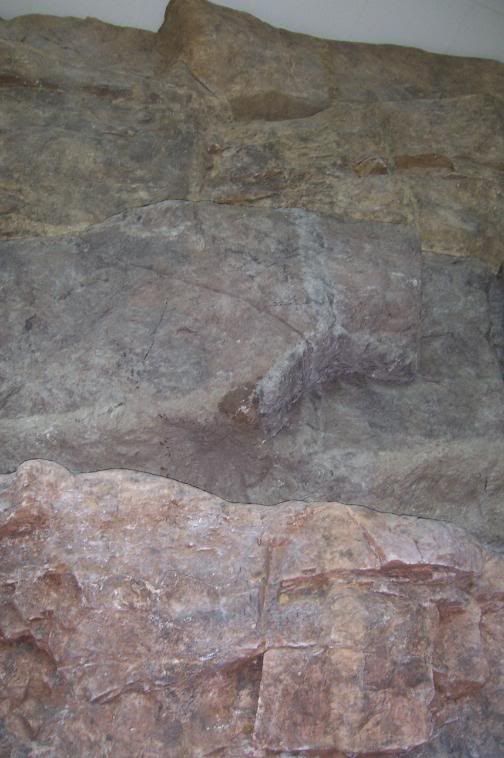
This was the wall inside the entrance of the
Pterodactyl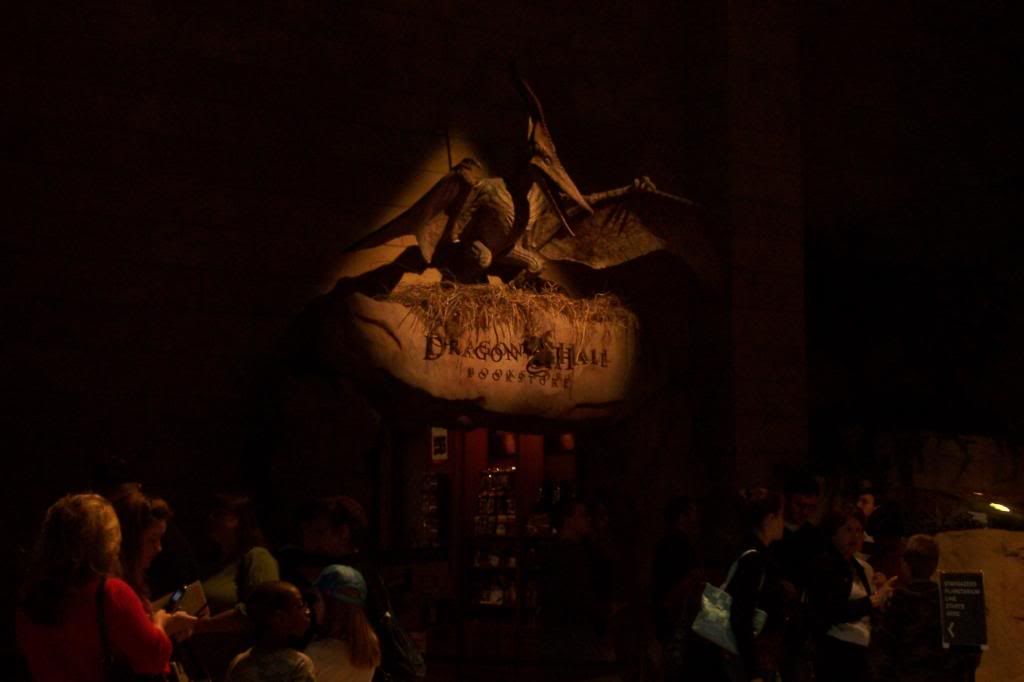
This Pterodactyl reigned over the bookstore.
First View of exhibits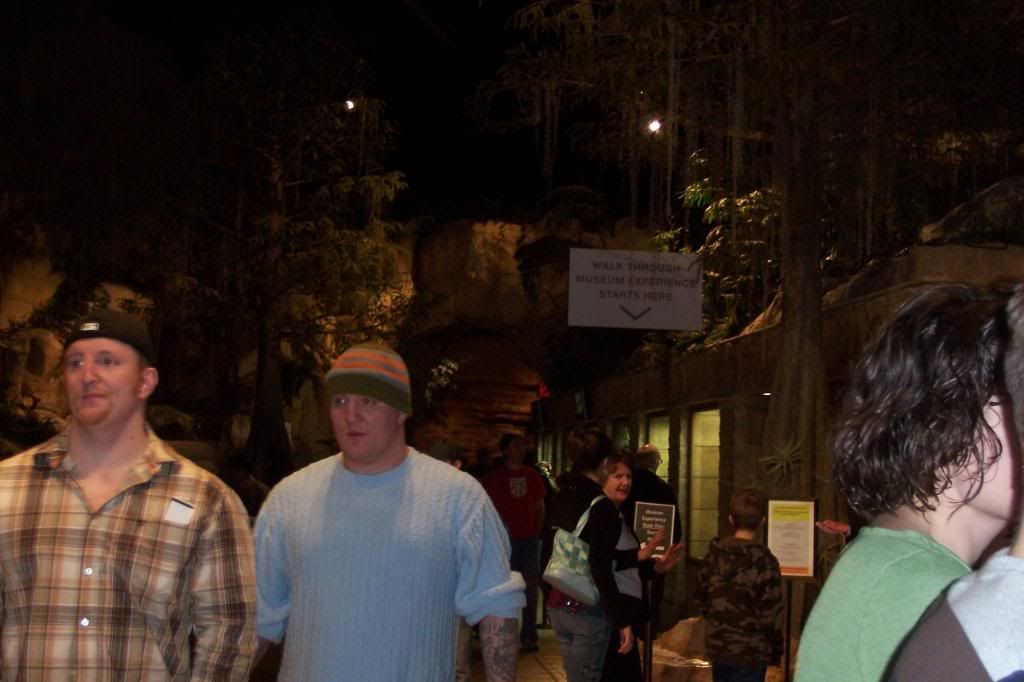
This was the first look into the world of the
========Side Note========
In the Bathroom

Though I do not usually take pictures in a bathroom, I thought this was too good to let go. Not hygiene, oh no, this is where we dispose of the women.
I also overheard in the bathroom a few women talking about the planetarium. One said that they remembered going to COSI and seeing a planetarium show that began with "Billions and billions of years ago." She was excited to see the truth presented.
========End Side Note========
We moved into our first experience, the Men In White movie. The movie was prefaced by a staff member, fully in paleontologist get-up, explaining that it was supposed to be a fun satire. It was going to discuss "stereotypes from your school days." It was also 4-D, so there were spouts for water and the seats vibrated when necessary.
Men in White was set up as a girl sitting at a campfire contemplating her existence. She is visited by two angels in white t-shirts and overalls. They explained many things to our campfire girl, who thought that science had proven evolution and the age of the earth. She was actually mistaken. God made everything in the world, and everyone in the world has a purpose in life.
There are many lines of evidence cited in this presentation. One of the main issues in science is the idea of "billions of years". Obviously this cannot be true, since the Bible tells us that the universe is only about 6,000 years old. Now, scientists have found very old rocks, but the creationists here discuss the loss of helium from zircon rocks to prove that these rocks cannot possibly be as old as they are claimed to be. For more information, see Creationist and Geochemistry explanations.
We are also presented with the idea of ocean salt. There is more salt in the ocean every year, and if the world were as old as scientists say, the oceans would be completely full of salt, and you would be able to walk across them. Scientists discuss many main missing explanations for salt removal that the creationists tend to leave out. For more information, see Creationist and Geochemistry explanations.
Another line of evidence is the T-rex found with soft tissue still attached. This could show that the dinosaur was actually preserved during the flood, and is not millions and millions of years old. This is actually a very cool specimen, since it is a perfect example of exceptional preservation. Paleontologists do not come across these often, but sometimes organisms are buried in anoxic (no oxygen) environments. This made it possible to learn tons about the T-rex, and scientists were able to do DNA testing on the T-rex and learn just how closely related it is to modern bird.
The final couple pieces of evidence come quickly and without much explanation in the video. Quick and dirty, magnetic fields and supernovas are introduced. Basically, the earth's magnetic field is going away, and so if the world were actually several billion years old, we would not have a magnetic field left. If the universe were as old as scientists claim, then there would be big supernovas, which we do not see.
Variety was given to eat kind by God. This means that inside of the two cats that were on the ark, God placed the ability to form many different varieties. This is how you get all the cats in the world from the ark. This would work quicker than evolution, and could happen in the Biblical timeline.
We are taken to school rooms, and shown ugly, angry science teachers who do not know what they are talking about. As the boys begin to show a slide-show of the "God did it" persuasion, the teacher is aghast, and has no answers to their questions about God. The teacher instead touts that
There is a quick mention of seeing a designer in the chair and therefore seeing a designer in nature (a nod towards the Intelligent Design movement of the old-earth creationists). We are finally instructed to listen to God's word and to teach the truth. There are also several mentions of how the evolutionary scientists work with the framework of evolution, and therefore all of their evidence leans toward evolution. We are left with the image of our campfire girl, who "does not want to seem stupid."
Leaving the room we heard several families describing the excellence of the video. It was difficult for me to stomach the children who were so very excited about the video. It was beginning to become apparent just how much this museum was geared towards small children, and how much the rest of the museum just might upset me...
Little Dinosaur Models 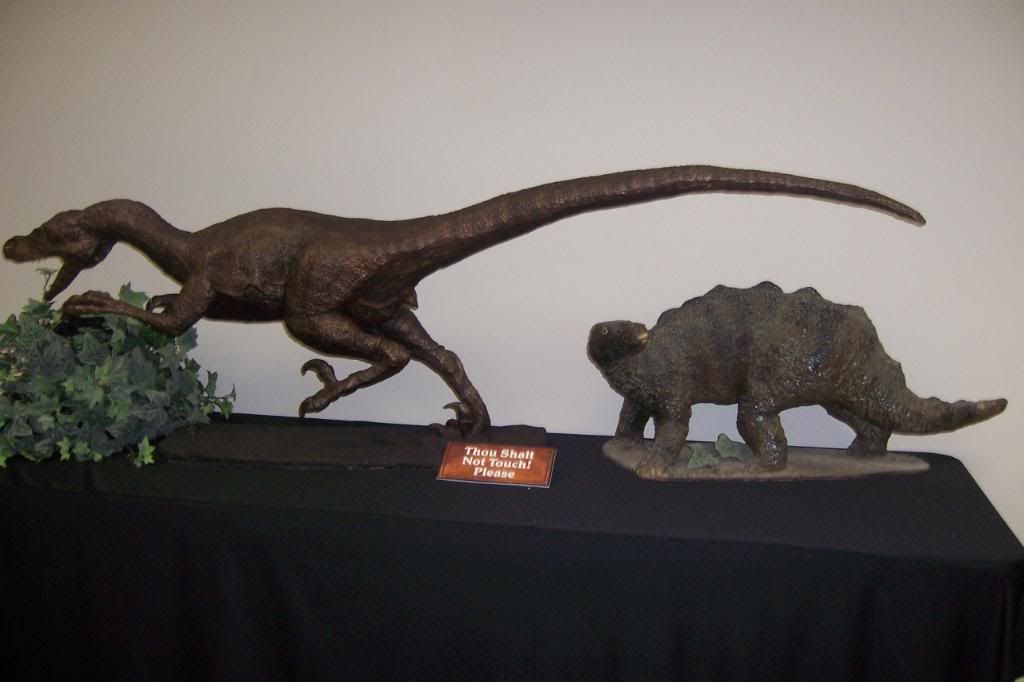
We ate lunch in a basement meeting room where these two set up. Note the sign, they were all over the place.
Because I do not want to use pictures here of actual people, you will miss the riding of the triceratops by myself and my friends. If you are friends with me on Facebook, however, you can see them there. There is also a man with a wheelbarrow of bricks who is intent on "Rebuilding our biblical foundations".
Cosmology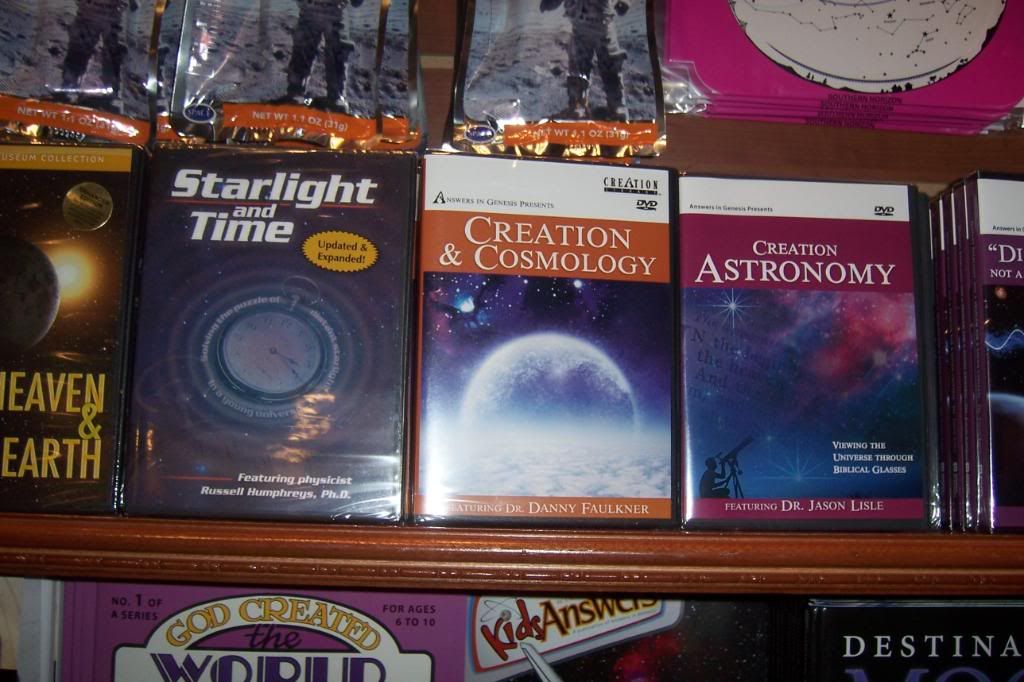
This was in the bookstore. I was always interested in the way they would deal with the universe, since my astronomer boyfriend scoffs at my measly "millions of years". There is a planetarium at the museum, and that description will be last, since it was the last thing we did when we were there
Part 2: Room 1 and the Variation in Life
This was when we actually entered the museum.
People and Dinosaurs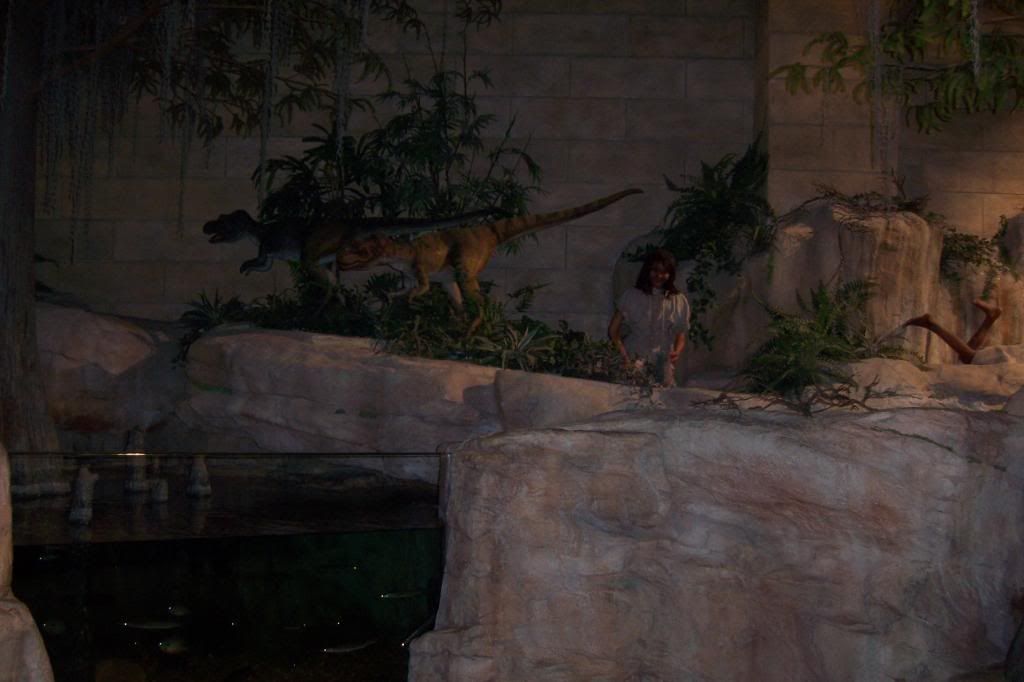
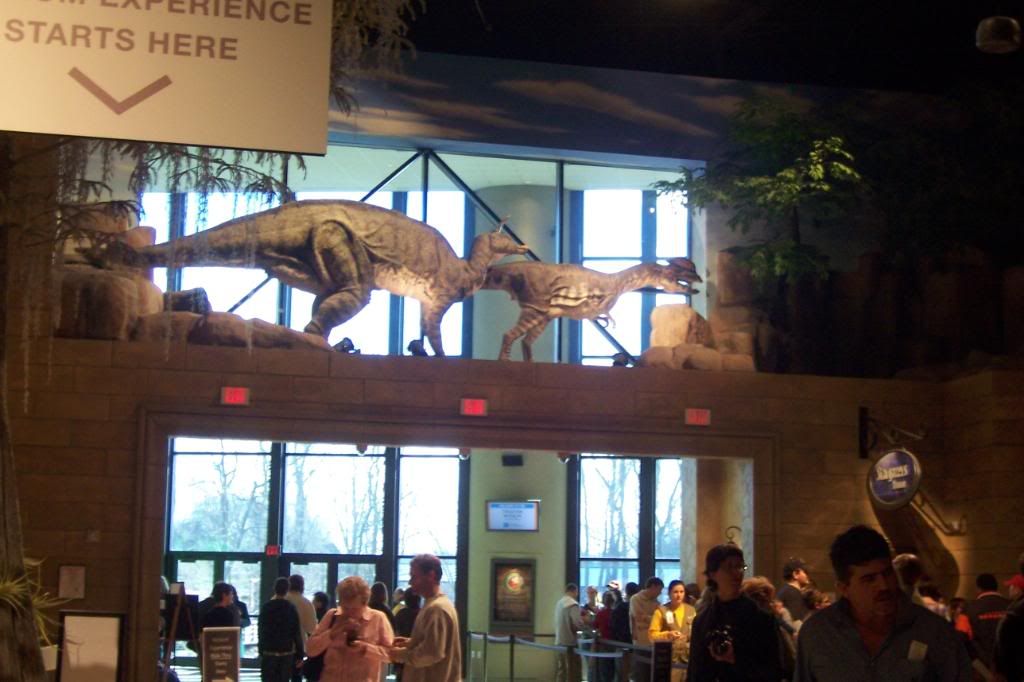
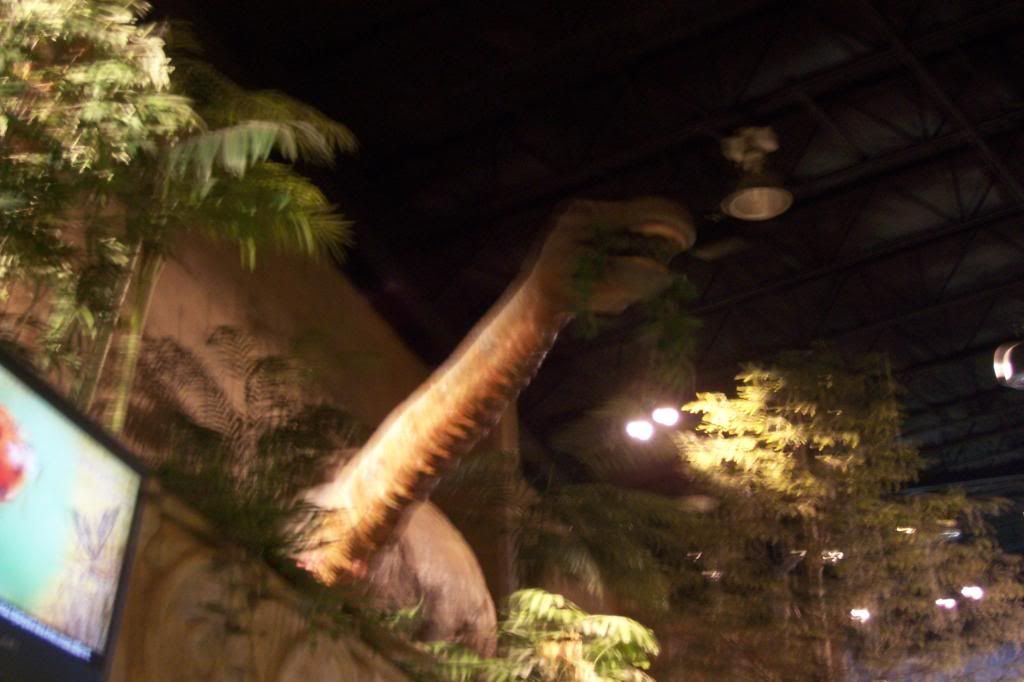
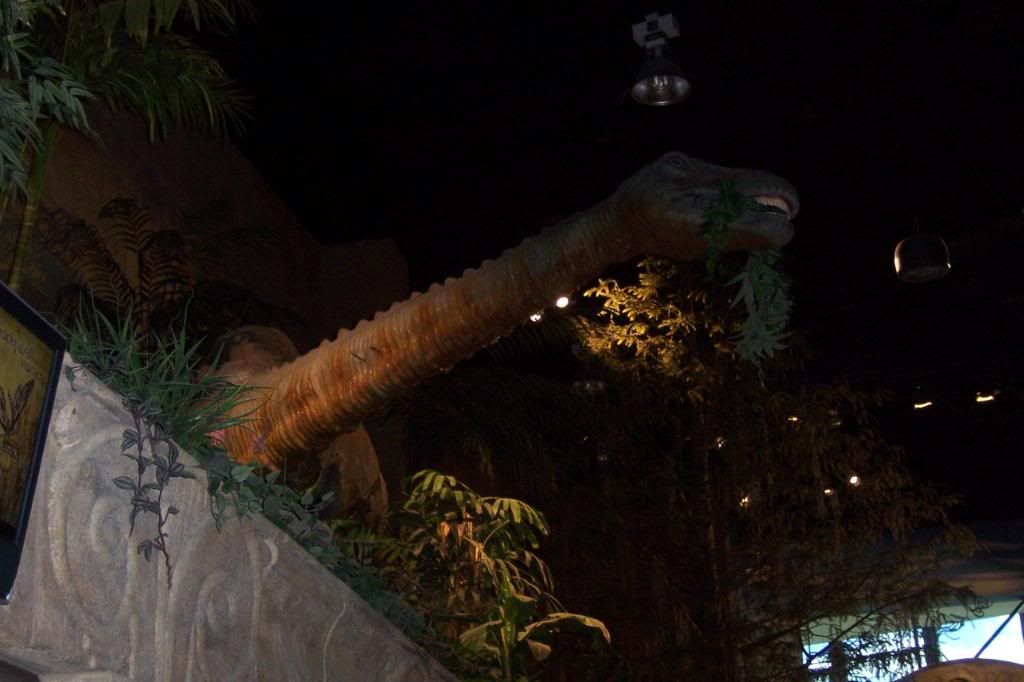

These are a little dark because the lighting in the area was not great. However, you get the idea. There are dinosaurs and people coexisting and no people are getting eaten by the carnivorous one.
Seven C's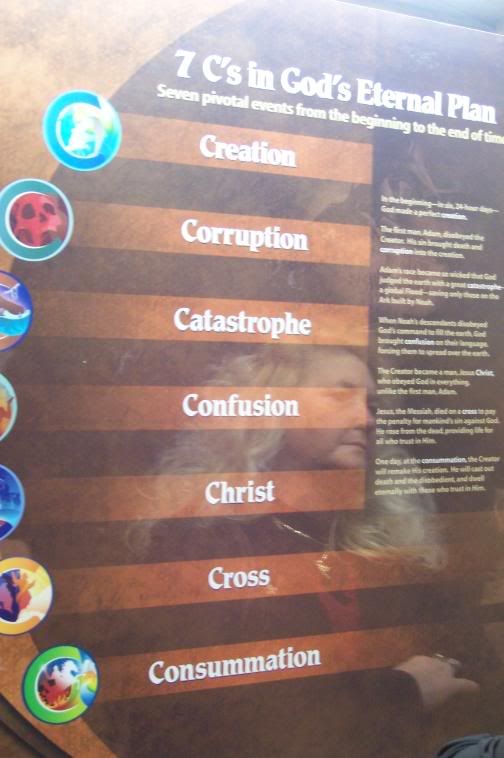
These are the seven C's of God's plan. They make an appearance in many parts of the museum, and they were mostly new to me from that perspective. The first four are treated in depth in the museum. Also, the women looking sadly into the window really shows how some of the people reacted to the museum.
Living Fossils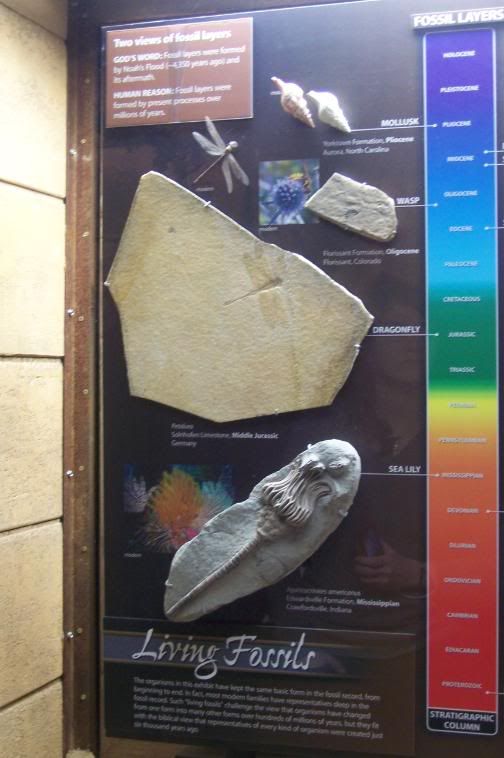

Living fossils display shows how some things have barely changed in "millions and millions of years" which proves that everything was created as it is today. I will discuss each of the examples in turn.
The oldest example are the stromatolites. As you may know, stromatolites are very important to scientists who study the origins or organisms. They are mats of blue-green algae (now usually called "cyanobacteria" because they are technically bacteria, not algae). Of course, we still have cyanobacteria today, but they are not in the exact same form as they were millions of years ago. These stromatolites let us know when there was first oxygen creating organisms on the planet, which helped to change the atmosphere into what we see today.
The next is the "Brittlestar". The current class is called Ophiuroidea. There are closely related to the starfish that everyone thinks of, but a separate class. Though these animals did diverge early on, and have not changed much in the time since the Ordovician, they HAVE changed, and the species then are not the same as those today.
Now that I look again, this is actually the answer to all of these organisms. Though they may have diverged long ago, there have been changes, whether they are obvious to us outside of their field or not (and possibly usually not). There is one thing I would like to add, though. They show that dragonflies diverged in the Jurassic, when they actually diverged 300 million years ago in the Carboniferous. Of course, they do not want to show the Carboniferous dragonflies which look to us strangely like our dragonflies, except that they were over 50 cm in wingspan. These huge dragonfly fossils tend to fly in the face of biblical thinking.
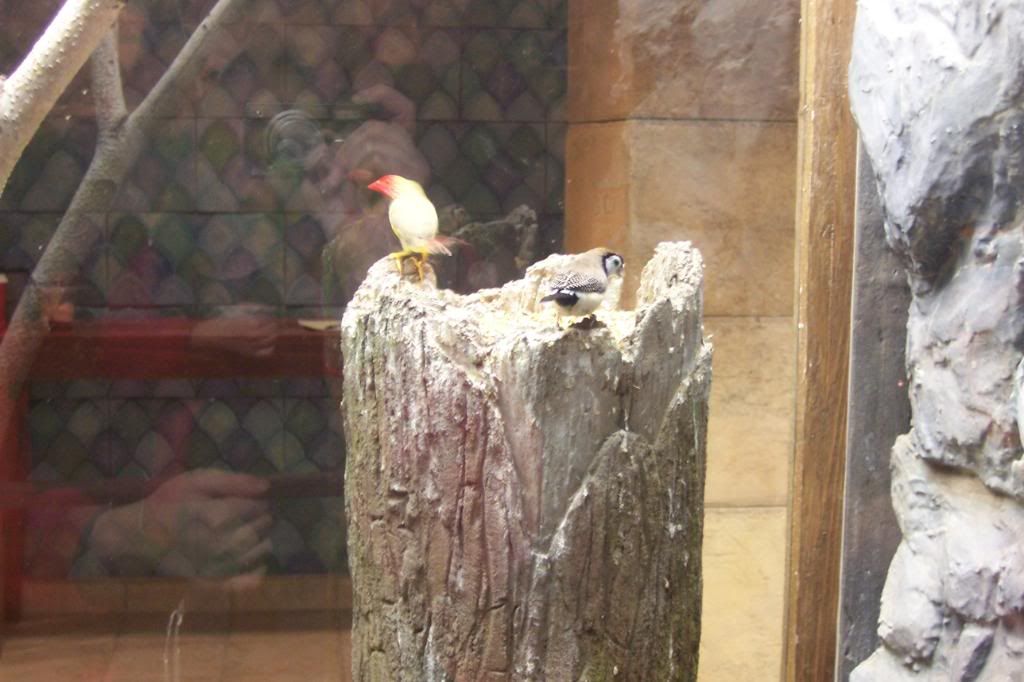
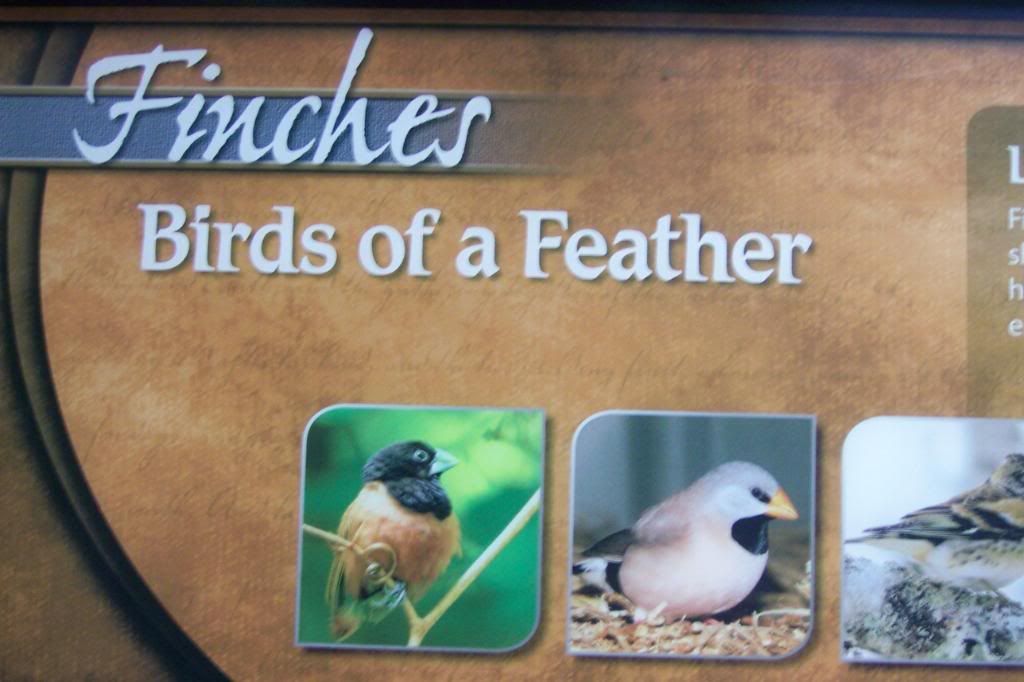
I was not surprised to see Finches as an example of Creation, since they are so often used by evolution scientists due to

There are many different species in many different environments.

There are certain birds that can interbreed. This is because species definitions get very complicated when it comes to birds. Even if a bird species can technically breed (which would make them biologically one species), they may have differing mating rituals which would cause them never to breed. There is clearly a miscommunication between scientists and others about the species concept and how it can be bent (especially in the light of new technology using DNA to determine what a species is).
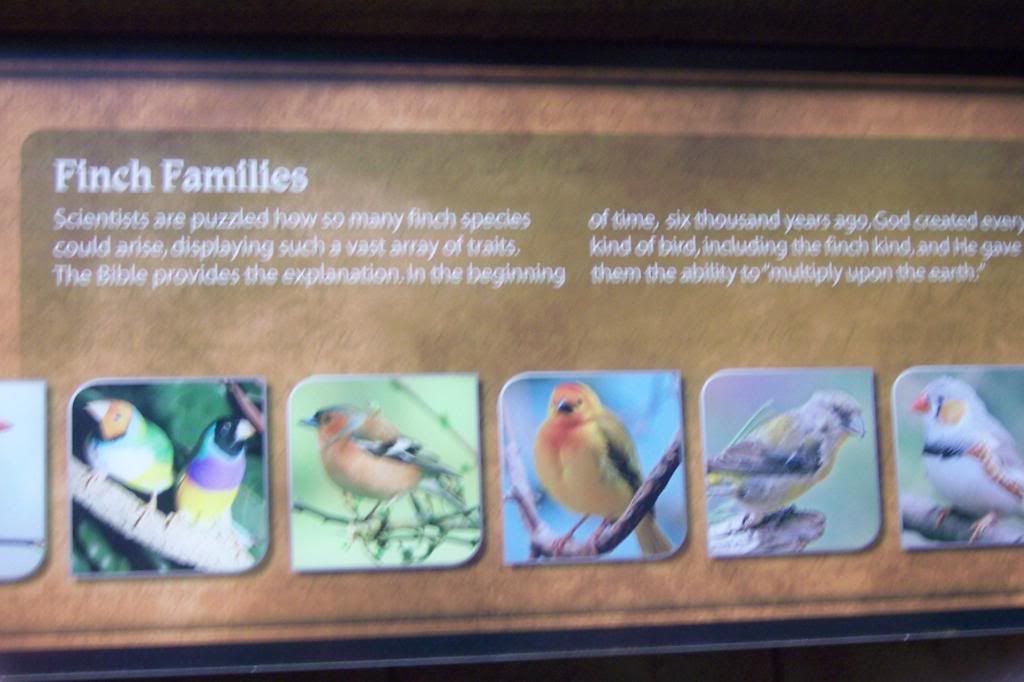
I do not know a scientist who is actually puzzled my variation. Variation is usually intriguing to scientists, because the next step is to determine how so much variation could have arisen in the given amount of time. Scientists use environmental factors (food, predation, competition) to discover how the animals could have arisen so many forms. I had heard the idea of the "kind" on the ark before, but I had not heard "multiply upon the earth" being skewed into the idea of variation being already implanted in the various organisms so that they could have become all the species on the planet. It turns out, however, that this is one of the big selling points of the museum, that this is how variation is possible.
Our Back Yard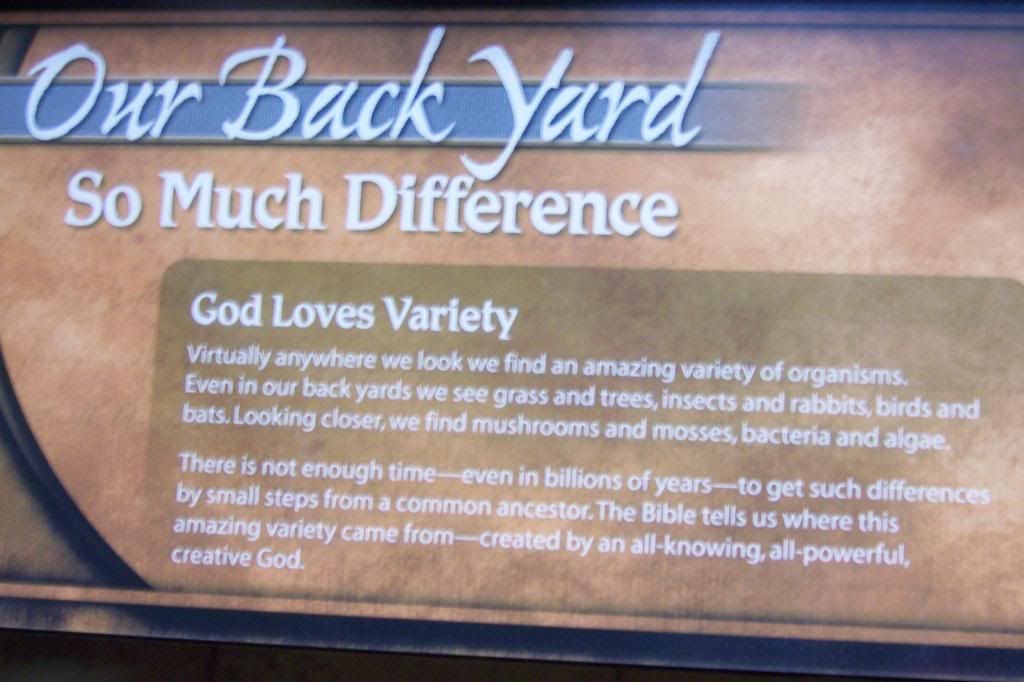
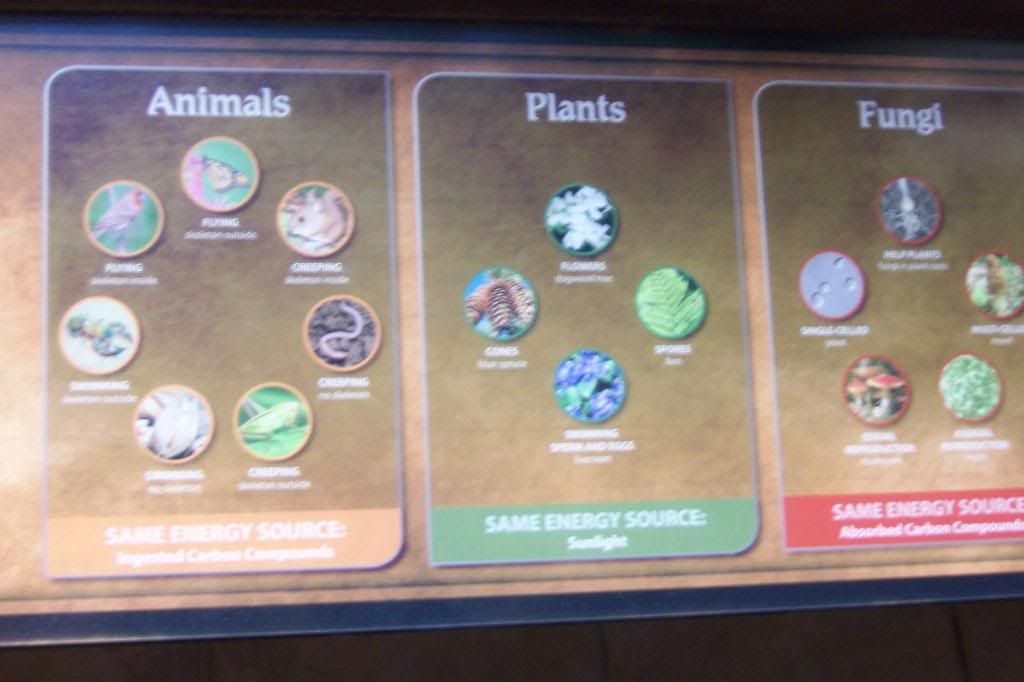

Obviously, there is a great deal of variety in the world. Of course, the claim that this all comes from small steps is not entirely accurate, though this is a common misconception.
Poison Dart Frogs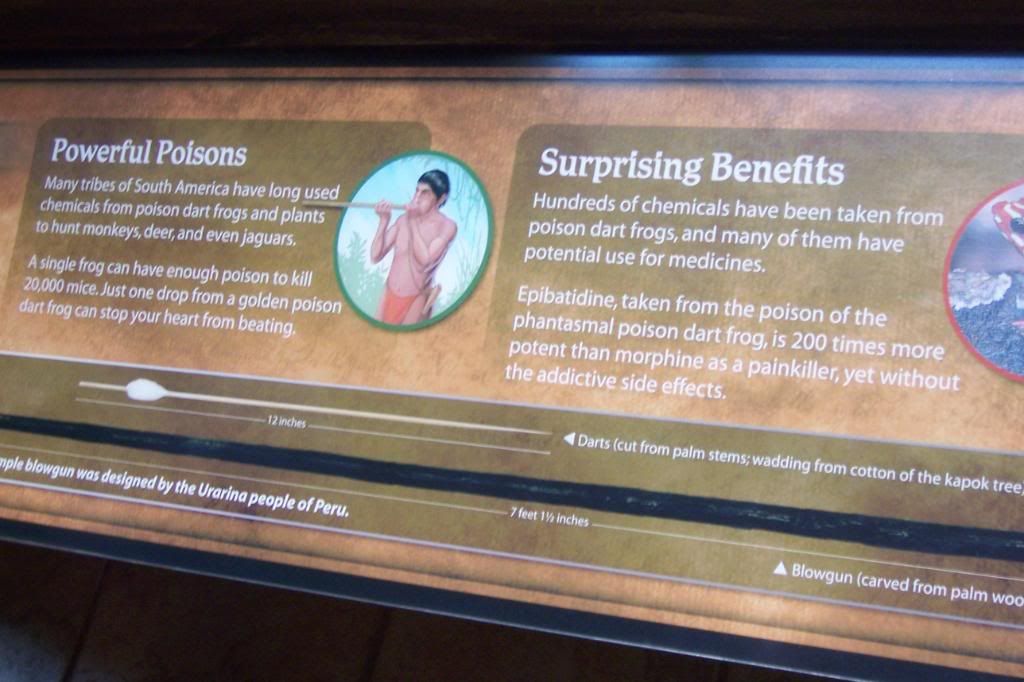
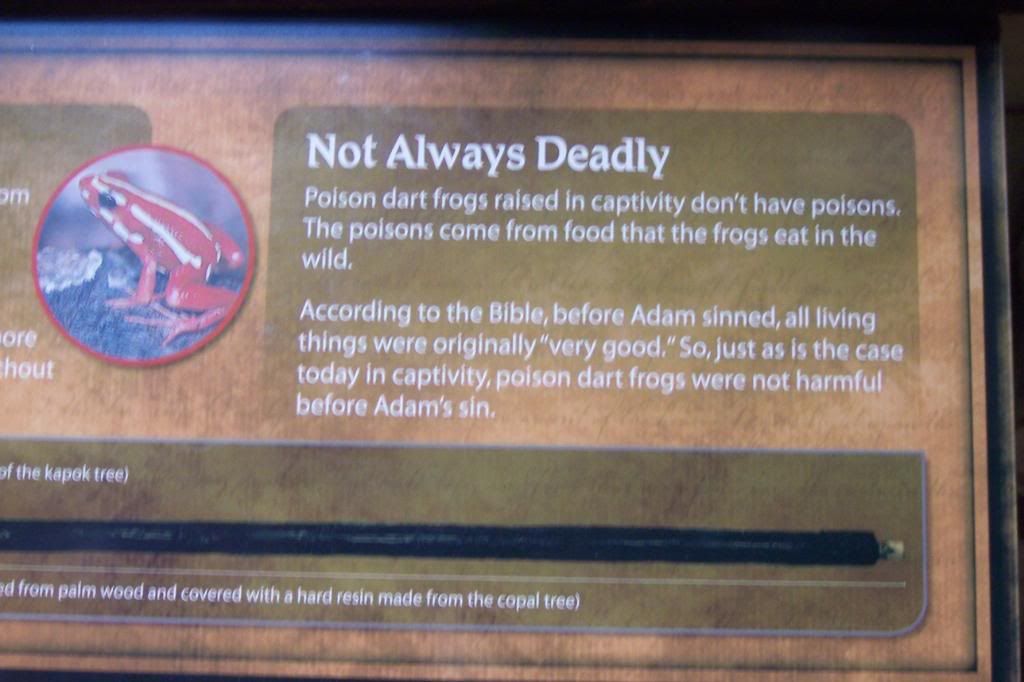
I could not get a good picture of the frogs because they were hiding. These frogs do have powerful poisons which have been shown to be beneficial in some instances. The museum does a good job of getting some educational information across along with the biblical stories. This doesn't mean that I am okay with it, but that is just how it is. Now here is also the first mention of the fall. When Adam sinned is when these frogs got their poison. There is actually an entire room later on devoted to this concept.
Chameleon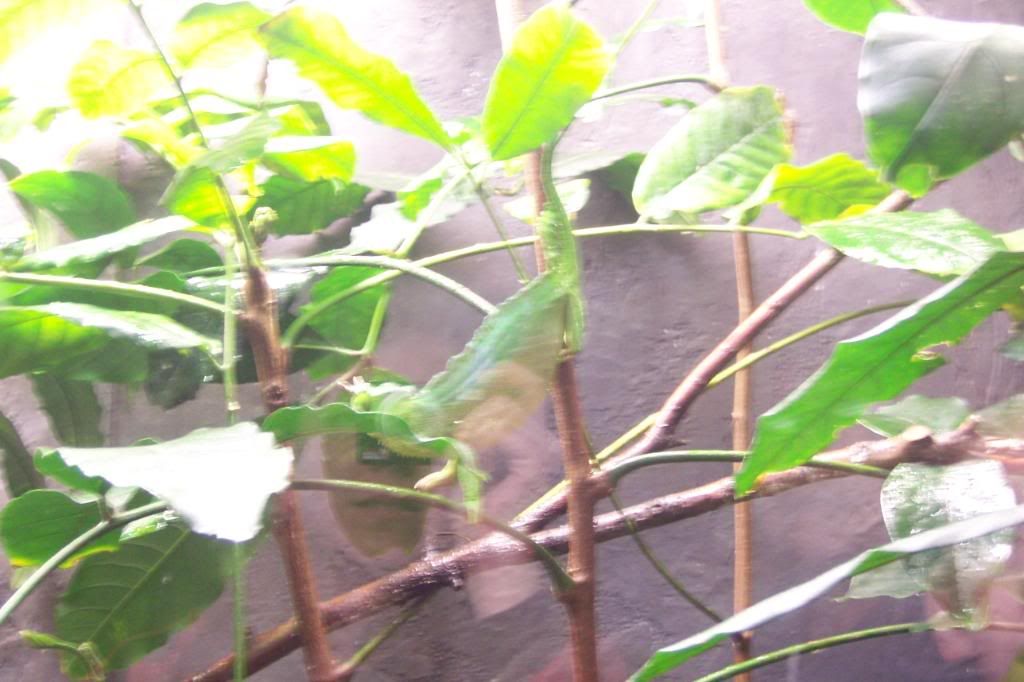
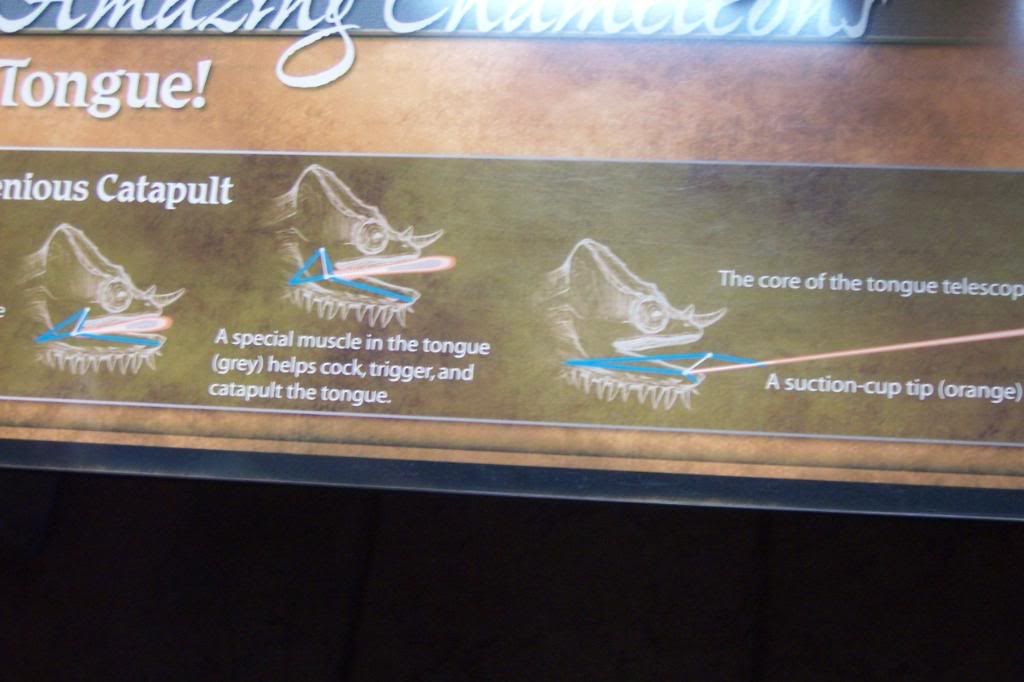
The chameleon is pretty sweet, we understand. There is really no explanation of why this is pertinent to Creation, but I believe the idea is one of "look at this cool thing God did". Also, kids love chameleons and I was beginning to see just how much this was set up for the kiddos...
Part 3: The Grand Canyon and Paleontology
The Grand Canyon
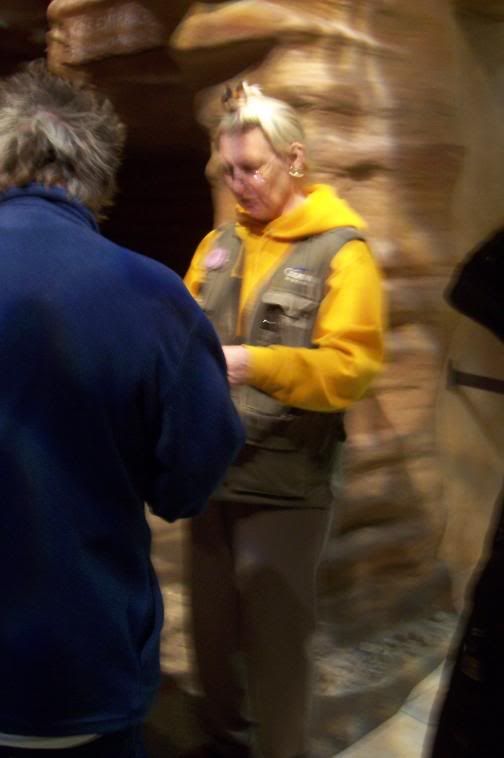
The entire staff was dressed in paleontologist gear. I was amused because my adviser once told me that you had to have your PhD before they gave you your vest. I do not think that these staff members have their PhDs...
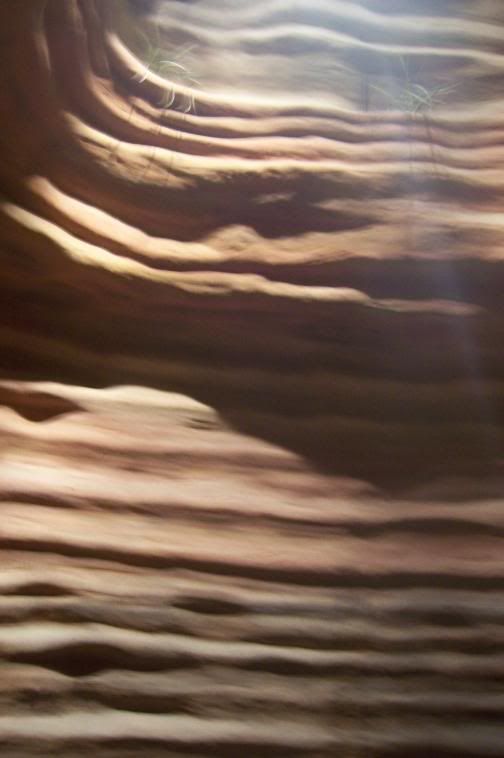
A wall of the grand canyon, in the direction that the adults were supposed to go. You can see the strata in the wall.
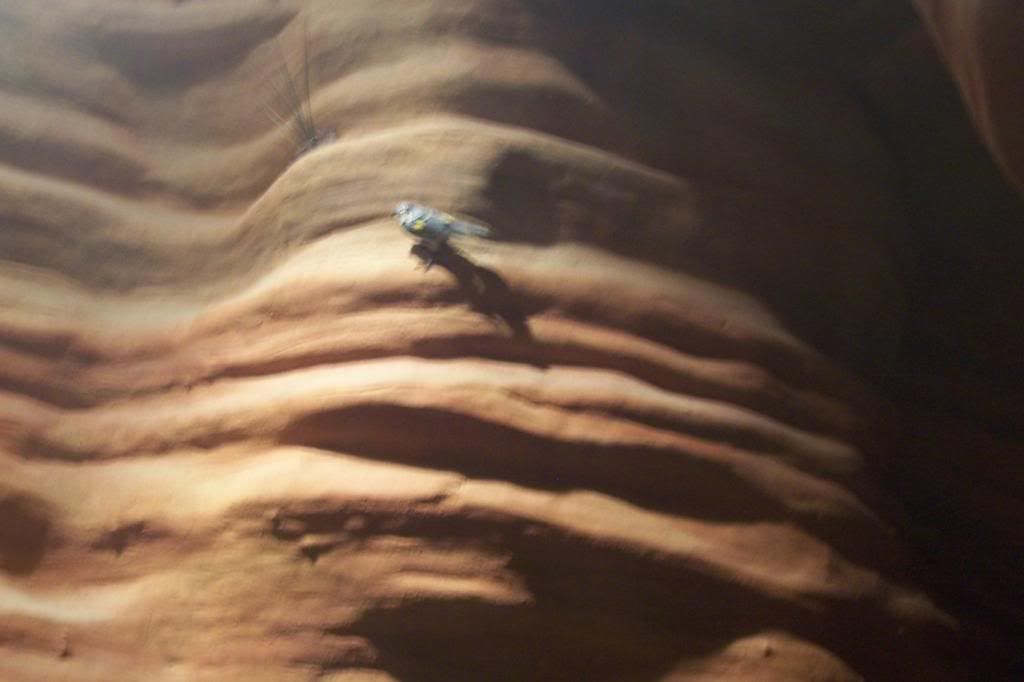
And there is a bird.
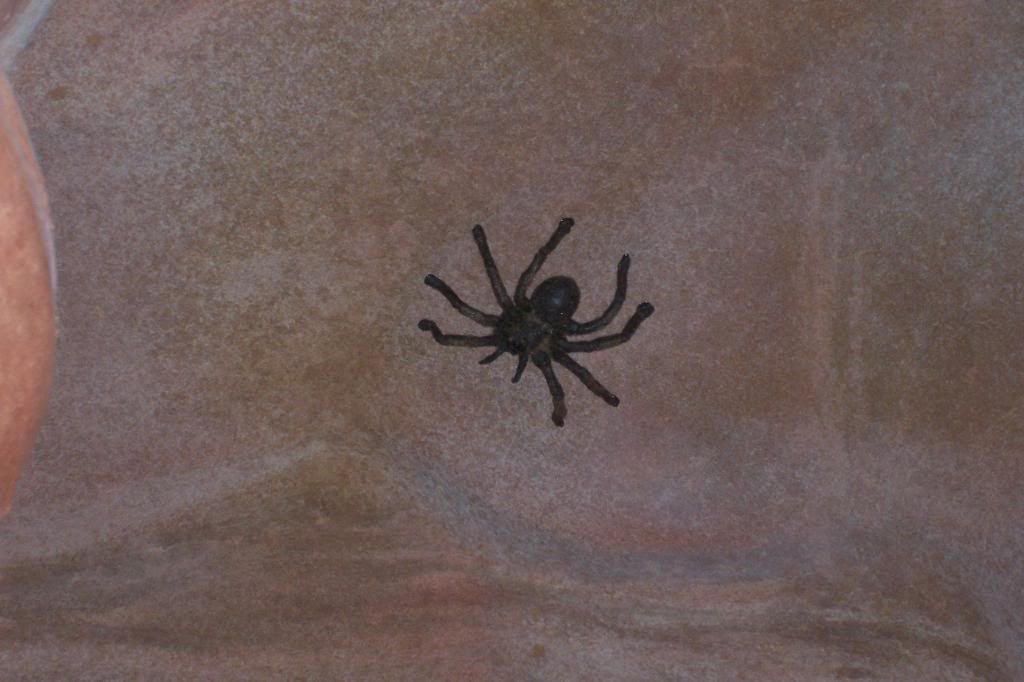
And a huge spider up on the ceiling.

This is a picture of how canyons are carved. There was a video accompanying this image. It discussed how Mt. Saint Helen's mudflows had created deep rifts in rock. There had been a "canyon" formed out of soft rock in a matter of hours, while one was created out of hard rock in 4 years. This explains how the grand canyon could have been carved in a small amount of time during, or just after, the great flood, instead of over millions of years by the uprising of the shelf and the
Paleontology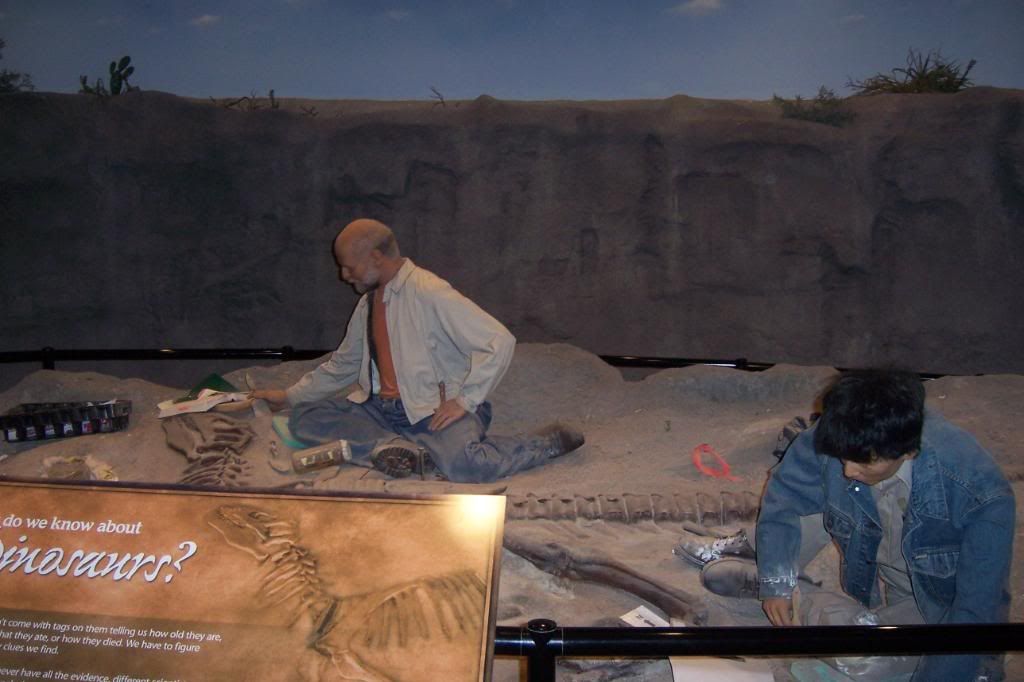
The first problem- all paleontologists wear hats. No, seriously, especially if they are out in the desert and they are bald. Lord knows the sunburn on a scalp is the nastiest of all.
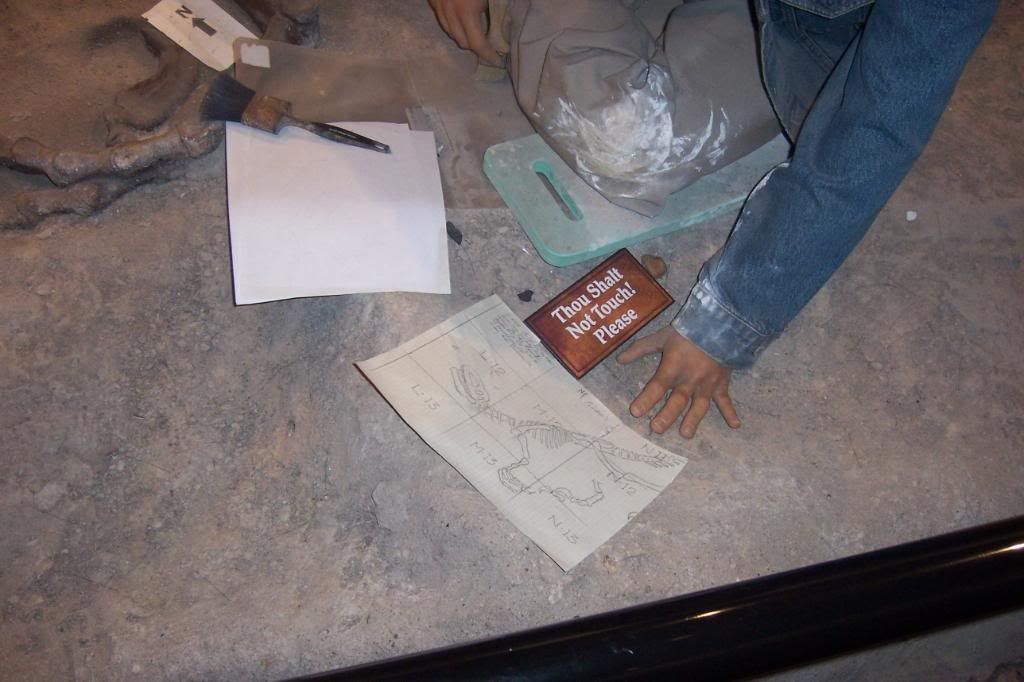
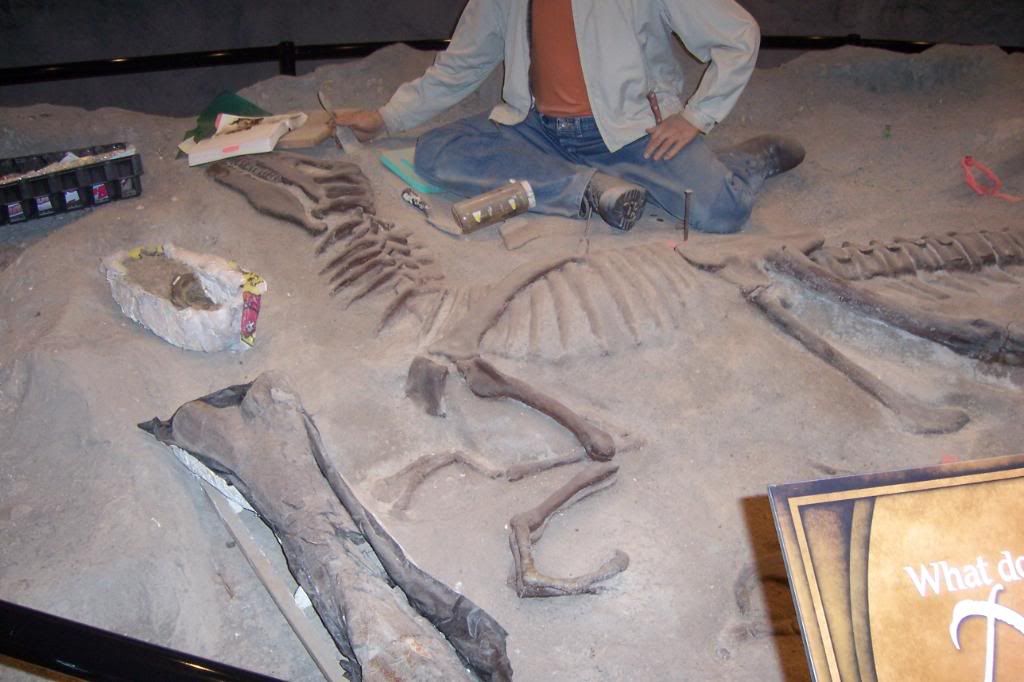
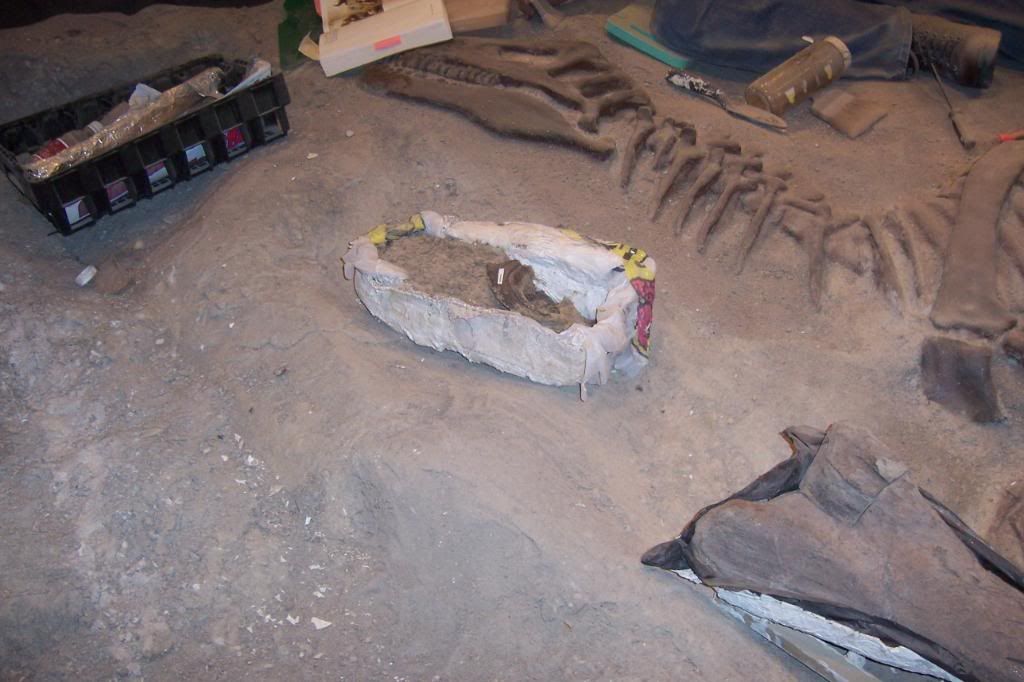
Other than the missing hats, this is actually a relatively good depiction of what happens on a paleontological dig. There are schematics made and the entirety of the fossil will be removed and taken to a museum or university somewhere. Of course, it is very rare that you find fossils in this perfect of an orientation or in this good condition. As a mammalian paleontologist, we usually find nothing but teeth. Though this is rare, it does happen, so depicting it in this manner is not blatant falsification.
There is also a video going on in the background. They show a Bible-based paleontologist who is happy, clean, and wearing a white coat. The other paleontologist is not Bible-based, and he is sad, dirty, and working like a dog.
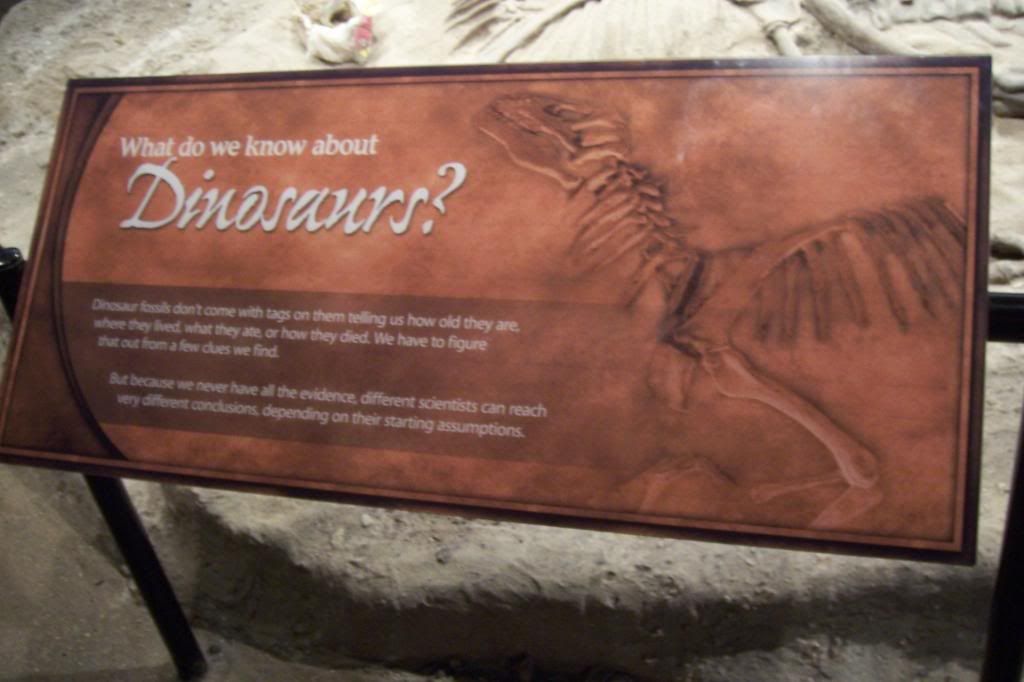
What do we know about dinosaurs? Actually a whole lot. Those conclusions that scientists make are often validated by information from other scientists work. It is true that some information means different things to different scientists, but this is part of the scientific process. If scientists never disagreed, we would never learn anything new. The most ground-breaking discoveries and theories that completely change how we look at the world are often contradictions
Mountain Lion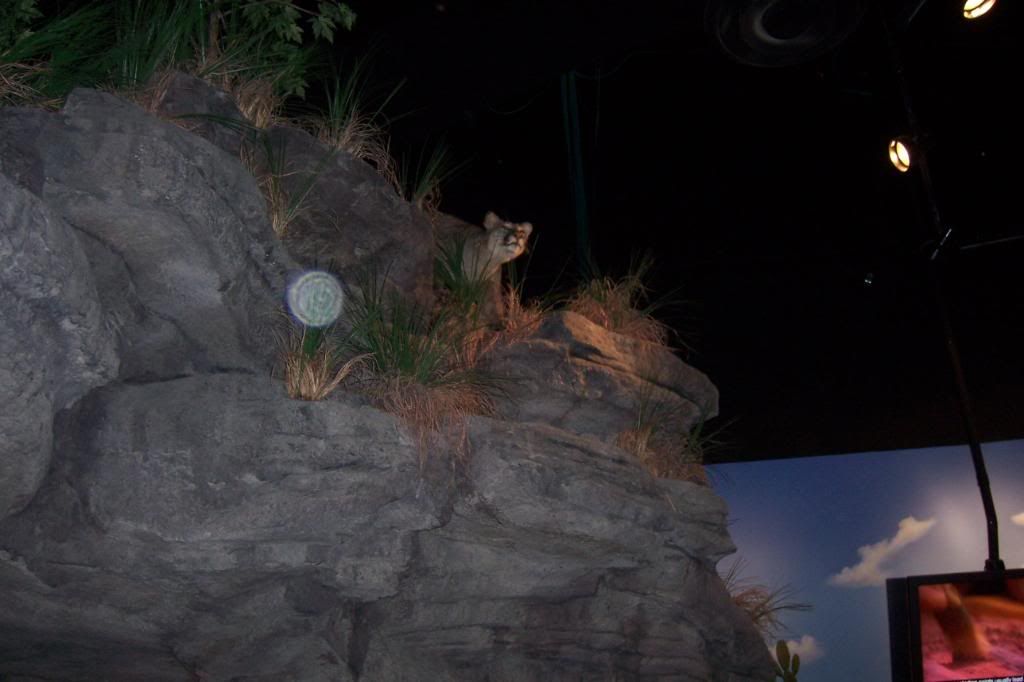
There is also a mountain lion laying in wait to take out our poor, unsuspecting paleontologists.
Sapphires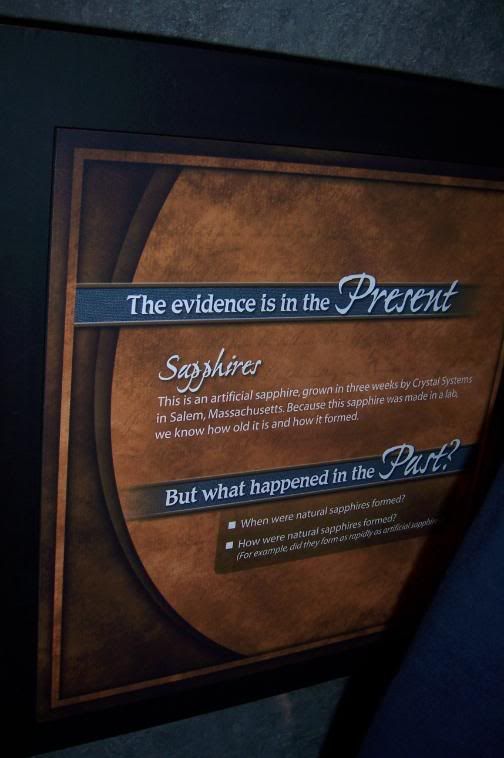
Sapphires can be created in a lab, but they are usually mined. I am not a geologist, so I do not have much specific information on this area of study.
Archaeopteryx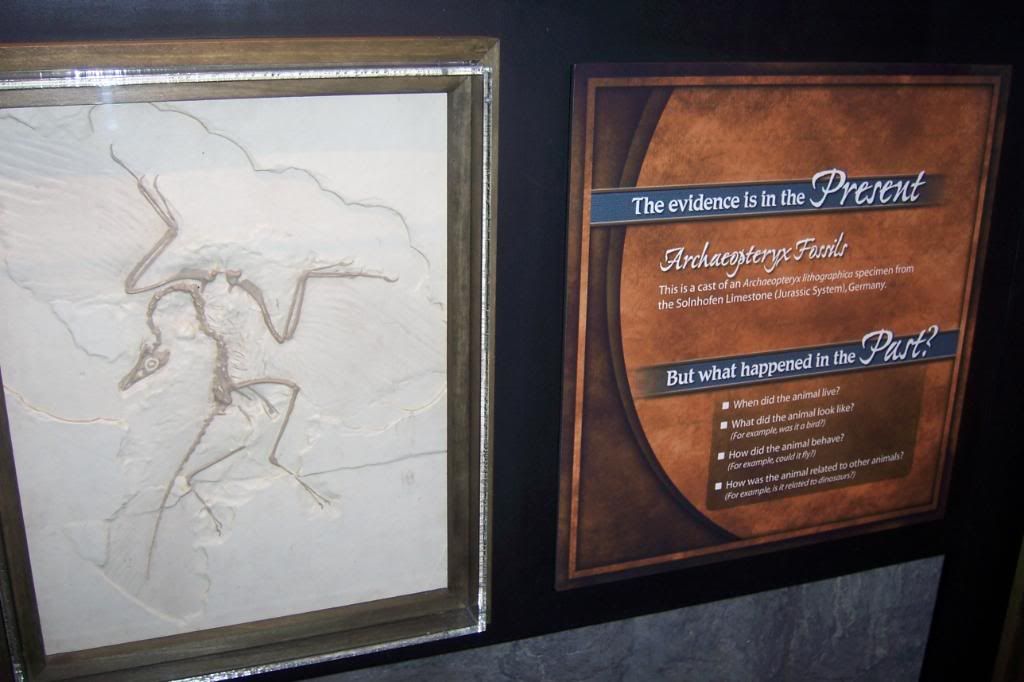
When did the animal live?
This animal lived in the late Jurassic.
What did the animal look like?(For example, was it a bird)
The reconstructions of this animal make it out to be a slightly more dinosaur looking bird, with longer legs, neck, and a slim body. Archaeopteryx is definitely a bird. Of course, from this fossil and others it is now known that many of the dinosaurs we know from
How did the animal behave? (For example, could it fly)
These animals probably did fly, though perhaps not well because of certain key features that this animal has that are somewhere between that of true dinosaurs and of birds. The feathers, however, are very similar to modern birds. It has also been speculated that these animals may have had sexual selection as modern birds, which might have had a hand in the increased rate of evolution in this group of in-betweens.
How is this animal related to other animals? (For example, is it related to dinosaurs)
It is well known at this point that Archaeopteryx shows many characteristics of both birds and dinosaurs. They way that ancestral relationships are preformed by scientists, this places its relationship as somewhere between these two groups.
Lucy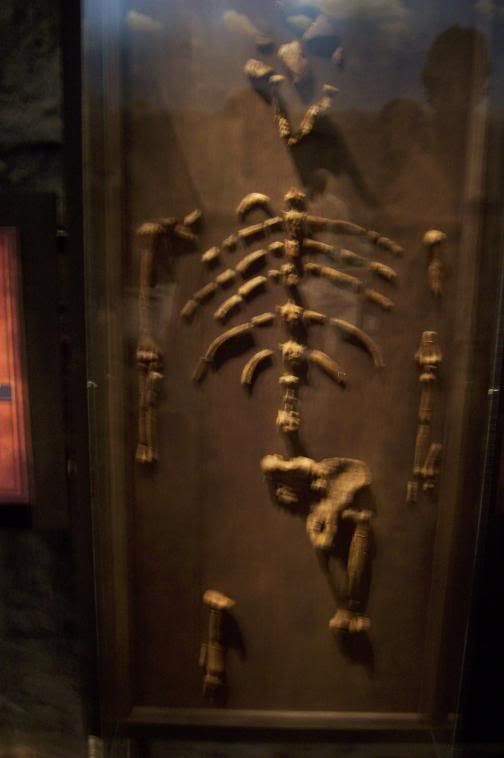
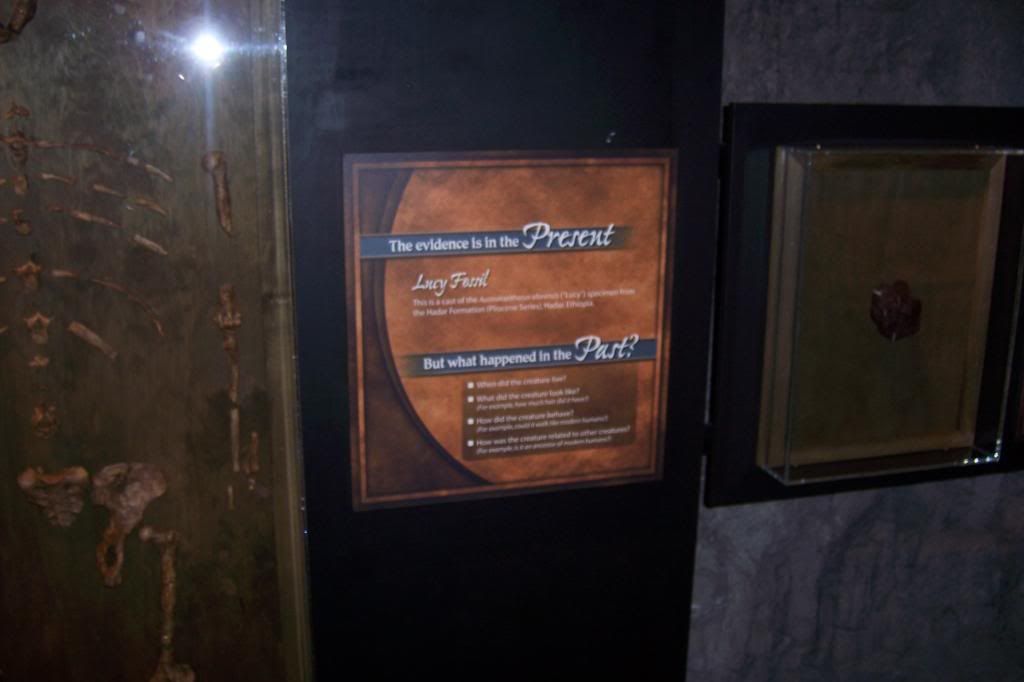
When did this creature live?
This is Australopithecus afarensis and it lived about 3.2 million years ago.
What did this creature look like? (For example, how much hair did it have?)
We can only speculate on things like skin color and hair of ancient animals. In most reconstructions they are shown as hairier than a person, but slightly less hairy than a chimpanzee. Their facial bone structure show us that they probably looked very similar to a chimpanzee or an ape, with a flat nose and a forward jutting jaw.
How did these creatures behave? (For example did they walk like modern humans?)
We do know that this animal walked upright as we did (as we see in their legs), though not as gracefully, and were still probably able to climb in the trees (as we see in their arms). Their gate is different from ours because their hips are between human and ape, and their knees are not exactly the same as ours. However, their knees are definitely upright walking knees.
How was this creature related to other creatures? (For example, is it an ancestor to modern humans?)
Yes.
Meteorites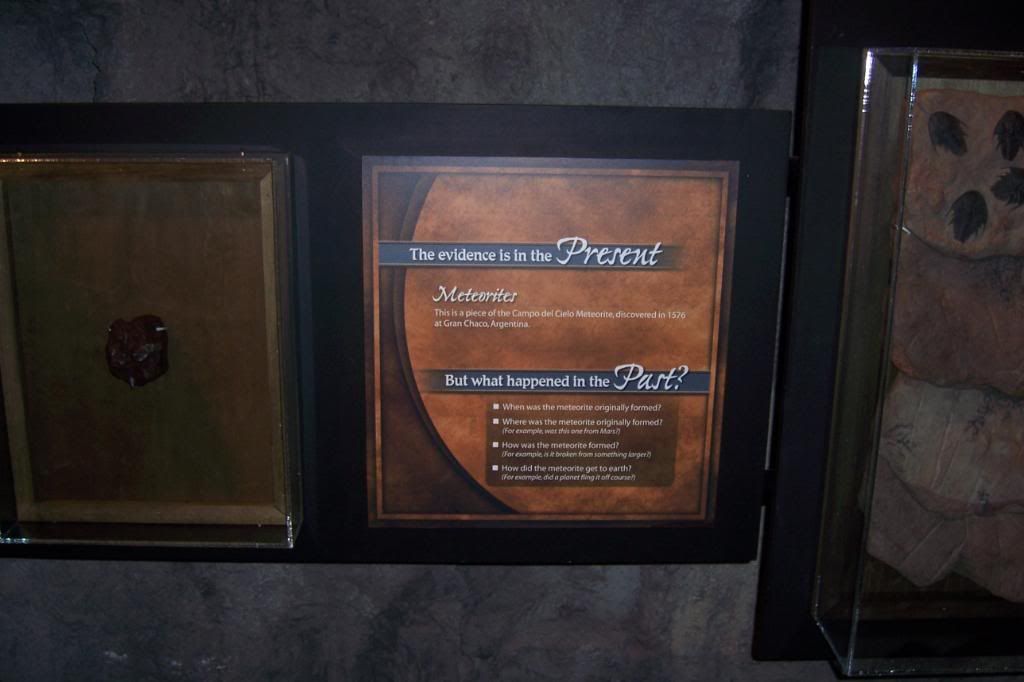
Meteorites are formed in many different ways, in many different places, and in many different times. Without having a geologist look at this particular meteorite, I can give no more information. However, there are geologists who could look at this and speculate to these questions.
Trilobite Tracks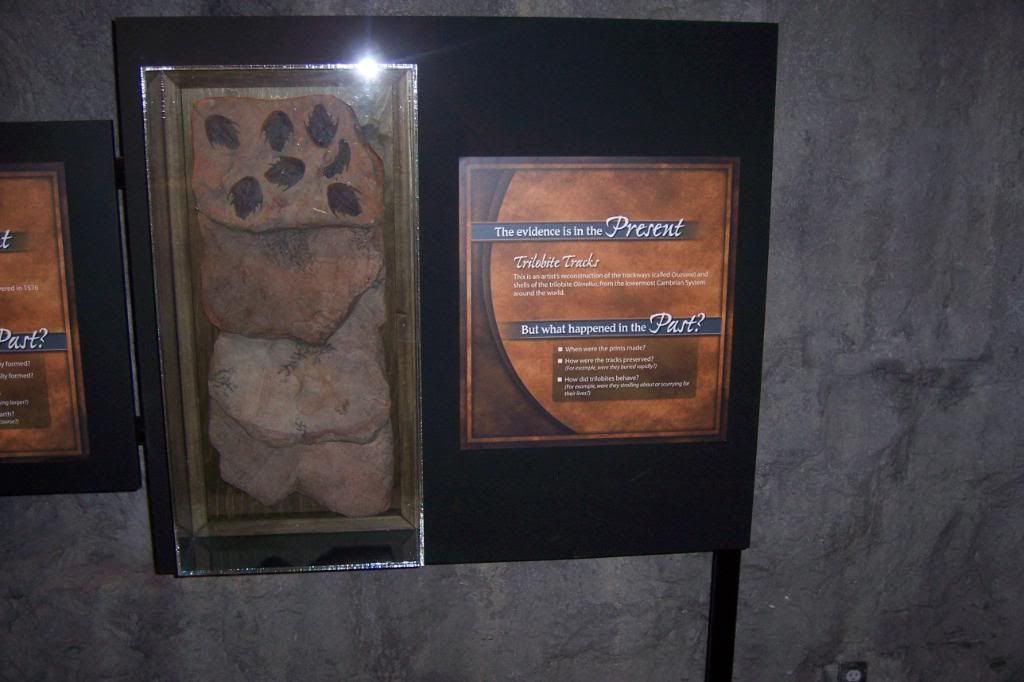
Again, this is not really my field of study, but trilobites are a very cool organism. They were around for 280 million years. Trilobites are studied because of their long existence and because specimens of certain ones are often easy to find (relative to, let’s say, mammal bones). Tracks such as these (though not made my trilobites) help us learn about the fauna before the Cambrian as well (before the “explosion” that is no longer thought of as an explosion). Those tracks can tell us that there were animals that moved in the sediment before there are hard body fossils. This teaches scientists that the beginning of life on the planet was a lot earlier than originally believed. Other than this, there is a lot of information out there about trilobite behavior. We now know that trilobites ate worms that lived in vertical holes by digging into the dirt a little bit, biting the head of the worm and sucking it out of the ground. Pretty cool, huh?
Caves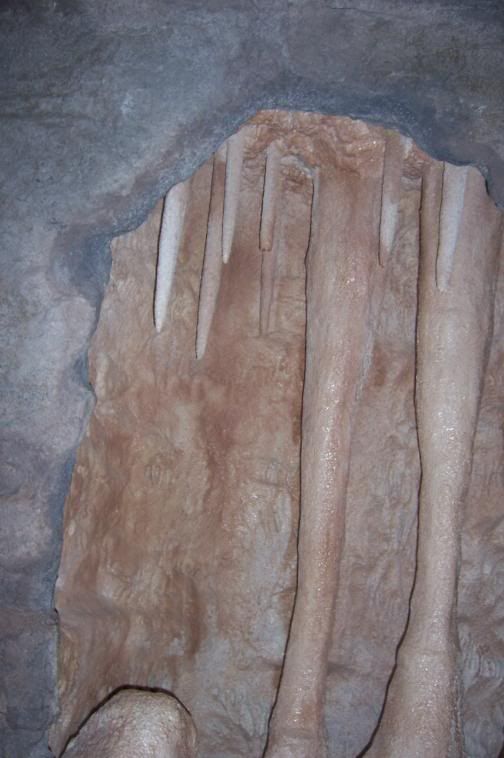
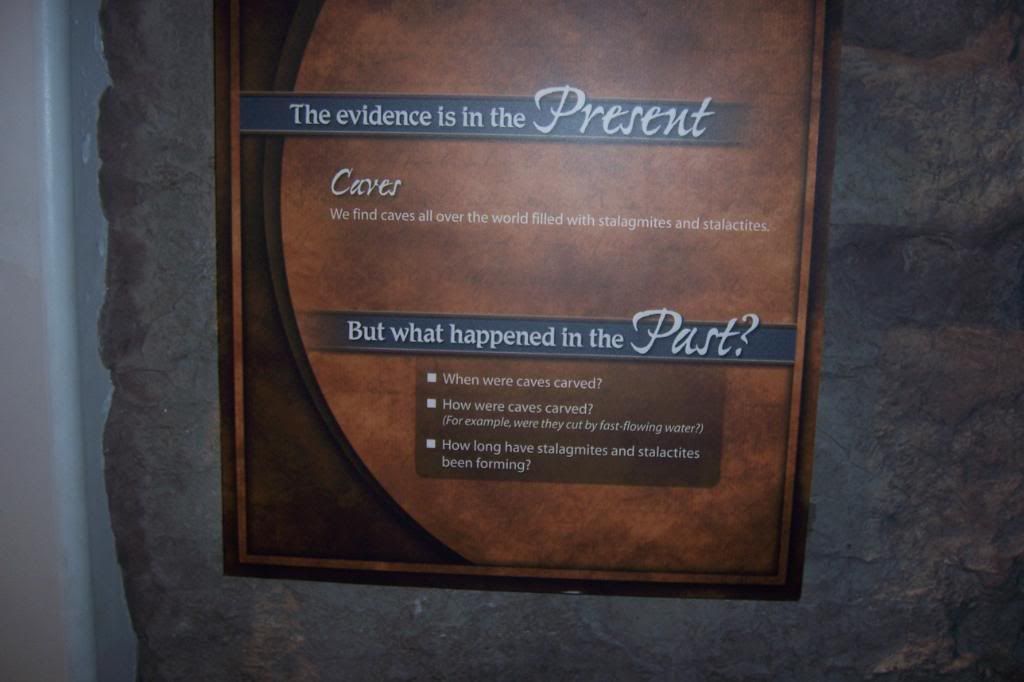
Caves were cut in many different ways. Often by water, or by the shifting of the tectonic plates opening holes where there was once softer rock. The stalagmites and stalactites take thousands and thousands of years to get to the sizes shown here. You can watch stalactites grow over the course of several generations from water running down them. In many caves across the country these are measured yearly to see how much they grow every year- which depends on the amount of water flowing through the top of the cave, and also how much material (usually minerals) are contained in that water.
Part 4: Same Facts but Different Views… Why?
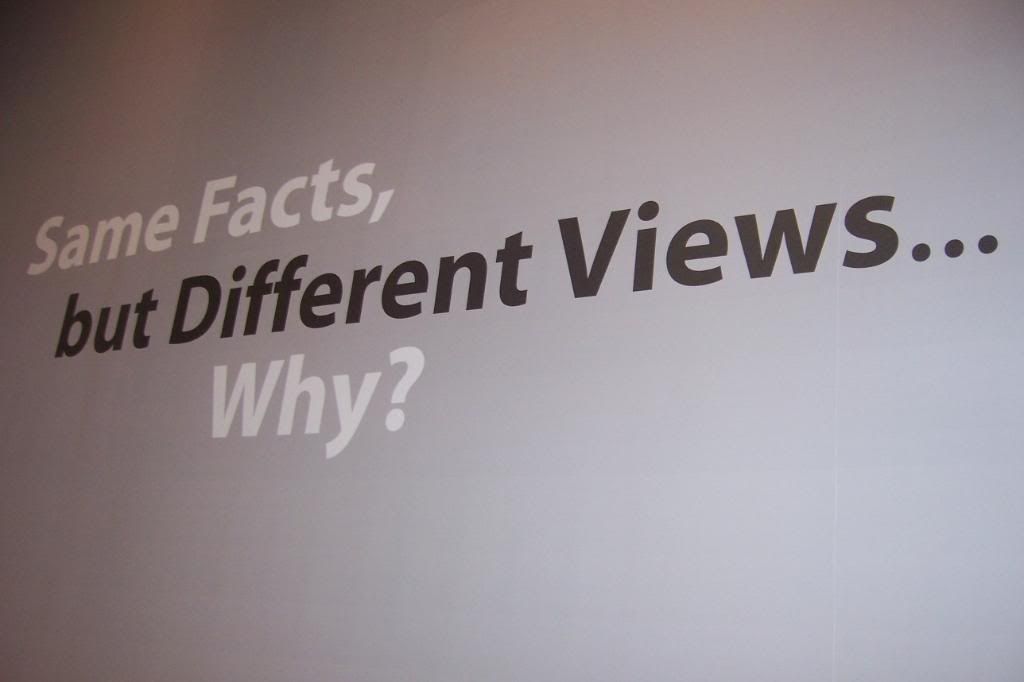
Dinosaurs
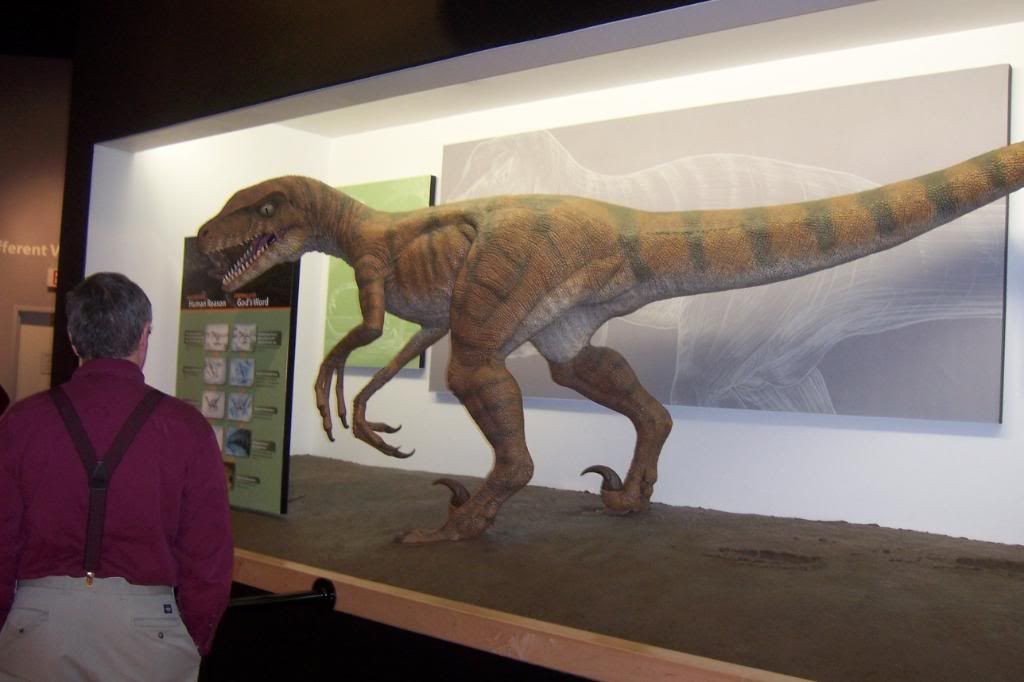
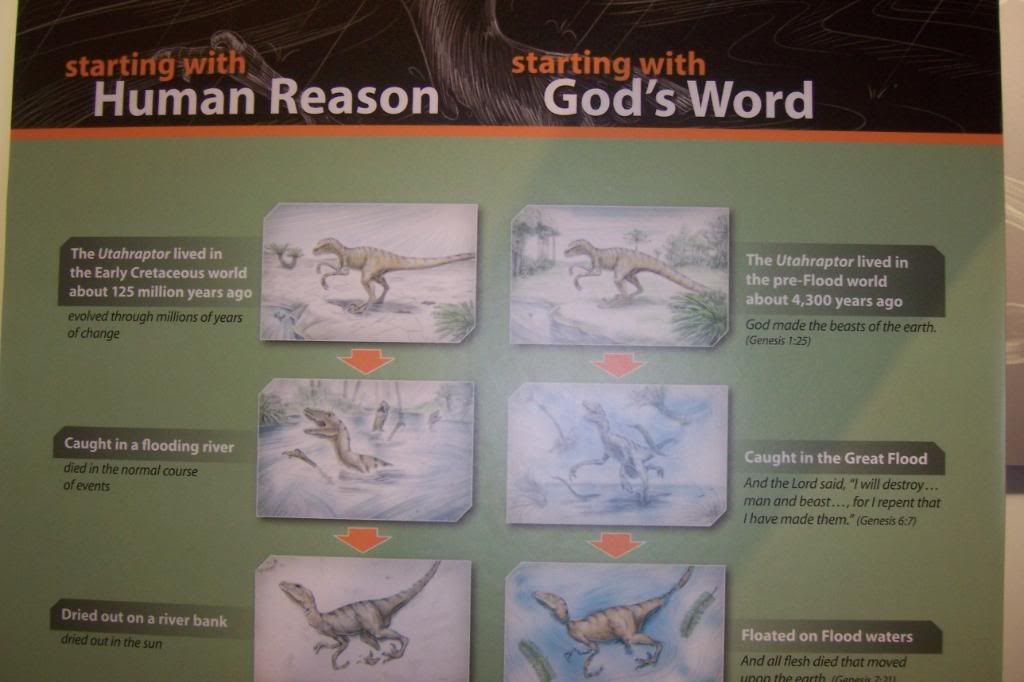
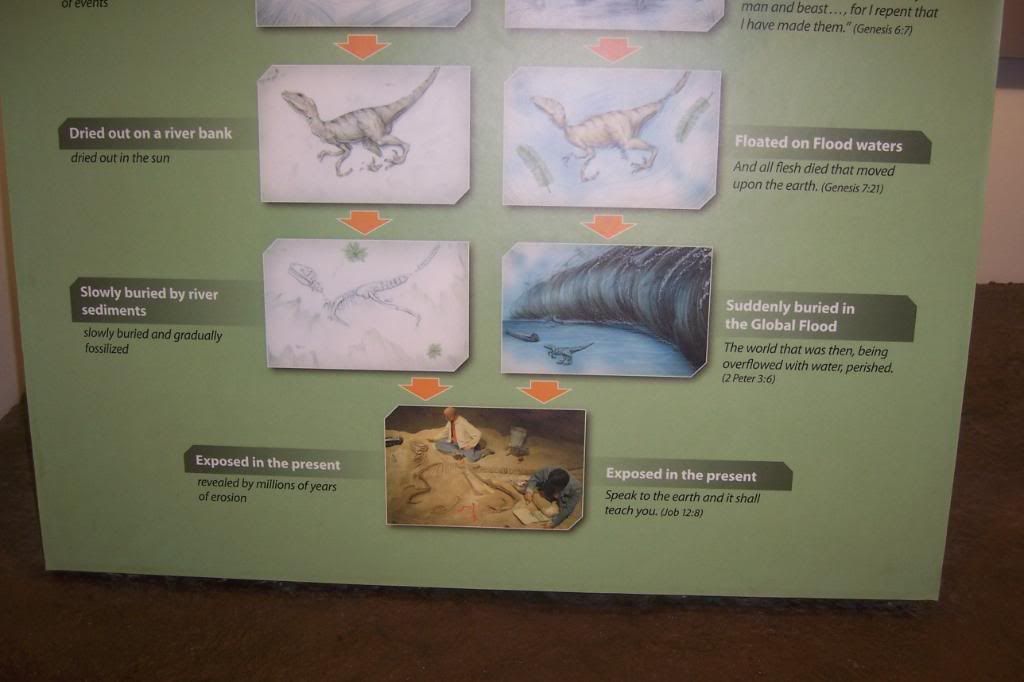
This is what comes first in this section, but the next set of pictures really captures the meaning of these rooms. This is on the right track of how scientists think of fossils, but not quite. This “dried out on a riverbank” idea is off. Most excellent fossilization happens in bog or lake deposits, because there you are more likely to find areas with little or no oxygen, which is a better environment for preservation (especially on the large scale that is shown from this fossil). Also, I have a hard time believing that a giant wave such as the one pictured would not just crush the bones. They also do not give any explanation for how fossilization could happen in such a short period of time.
Different Starting Points
The Crux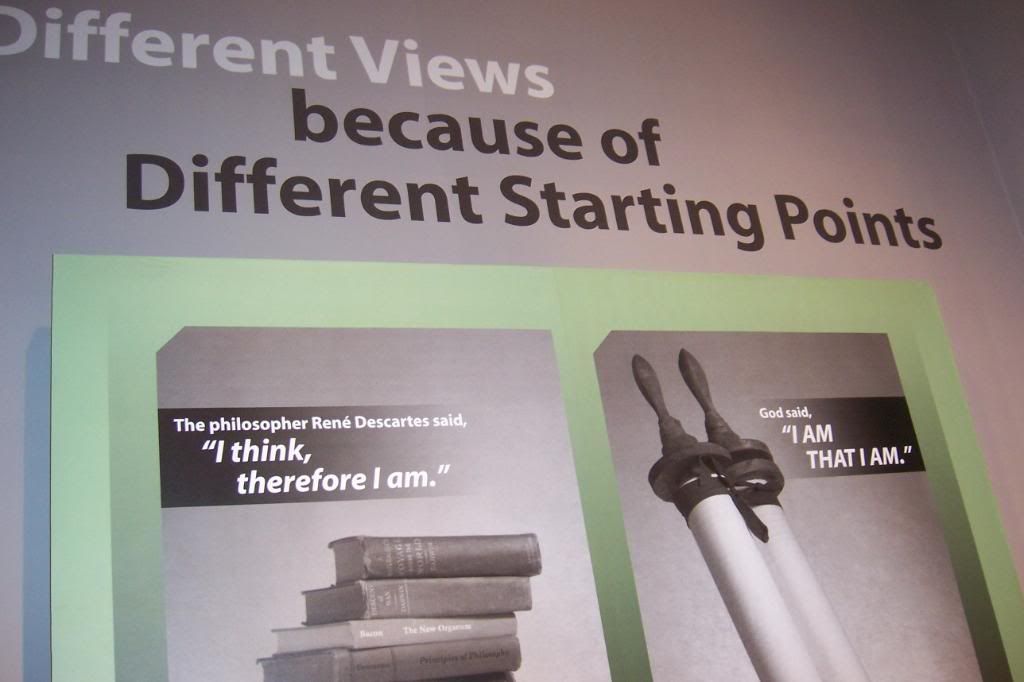
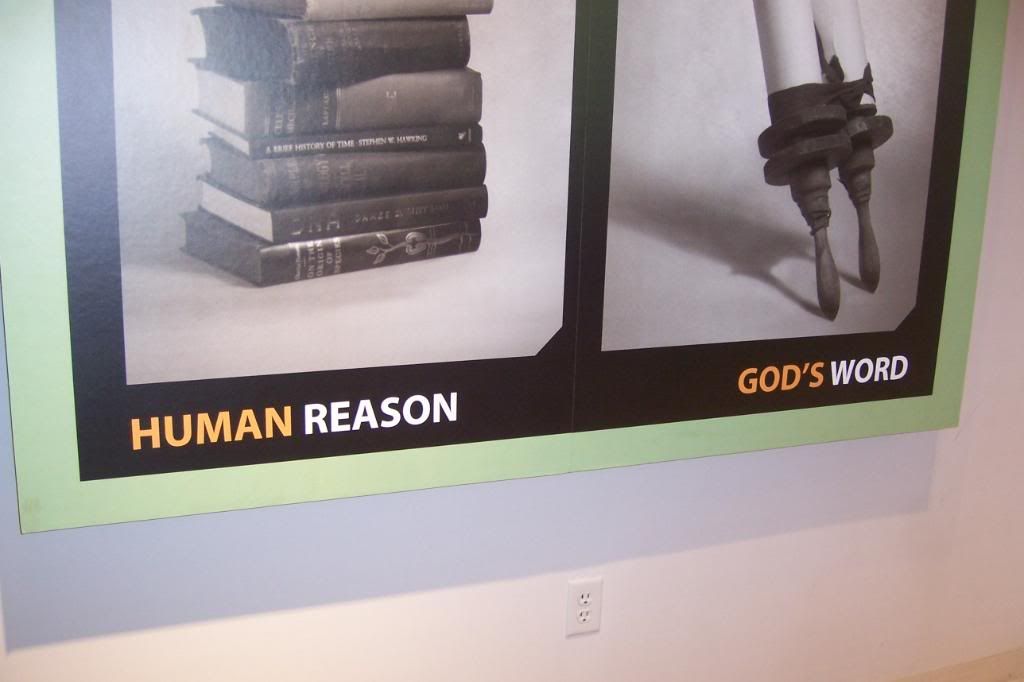
This is the entire crux of the argument from both sides. Of course, scientists do not see Human Reason as a bad thing. “I think, therefore I am”… does this mean that with God’s word we should not think? Is thinking to be outlawed? This photograph also shows that human reason has many, many books behind it, and we can assume this stack represents all of human knowledge. However, the opposing side has just one scroll. They do not need any other information, since all they need is that one piece of literature. Therefore, when any other information is presented to them, they can merely shake it off as “not in the Bible.”
Different Views of the Past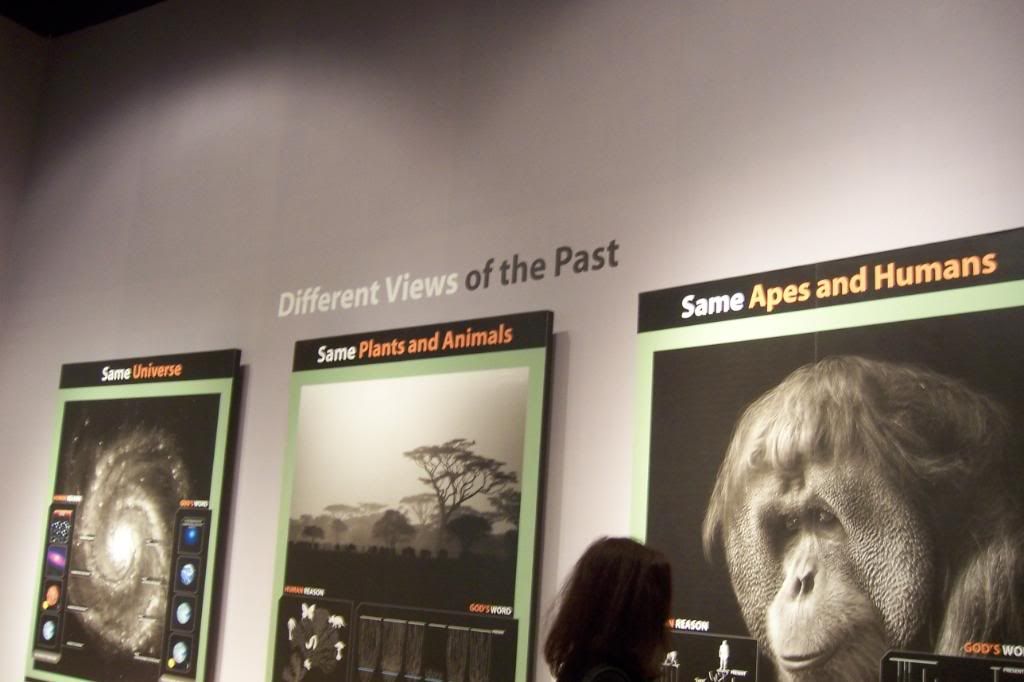
Same Universe
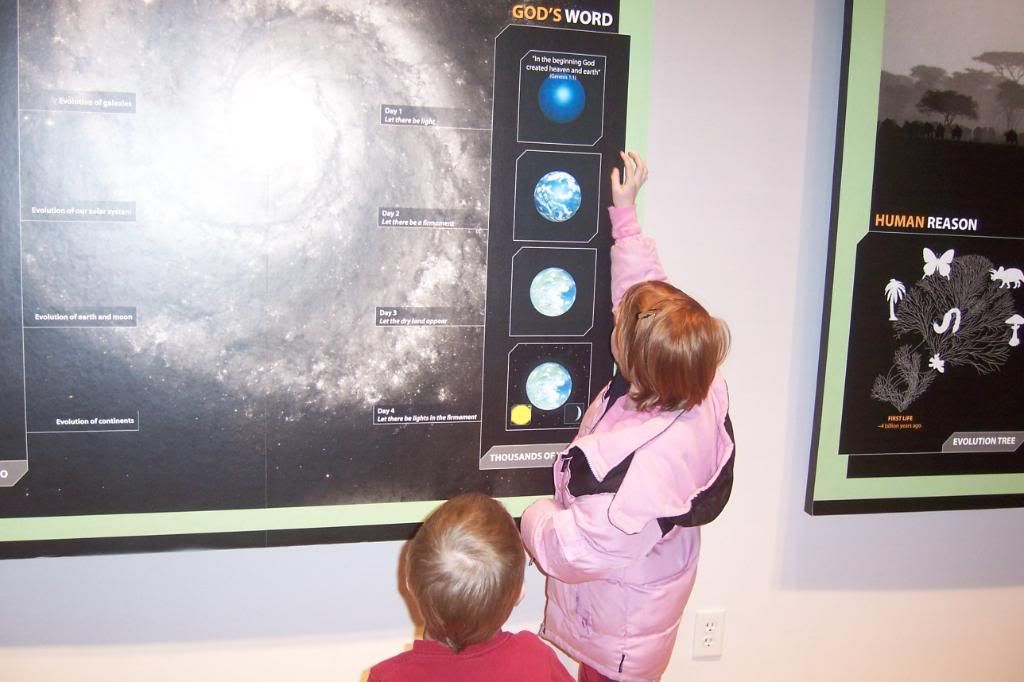
This was probably the most horrifying thing I saw all day. The evolution of the galaxies, solar systems, earth and moon, and continents going against the specific days of creation was not new to me, but these two children were. I would say the older child is 8 or 9, while the younger is 4 or 5. The older sister is thinking that she is doing right by her little brother by explaining to him what he is seeing (especially since he cannot read yet). She was showing him around the museum to help him understand. It hit me then that the indoctrination had probably begun long before this little girl had entered this building, but she had clearly been here before and understood each of the displays enough to explain it to another. This teaching is exactly what we are trying to keep out of our schools. I do not want my children subjected to in a science classroom, and I know many parents, teachers, school board members, and judges who agree with me. However, this museum gives parents another place to go to discuss this with their children. And since the museum was created with these small children in mind, it is a perfect learning environment (considering that some older natural history museums can be boring to children this young).
Same Plants and Animals
Oh, the chaos that is the humanly reasoned evolution bush. This was
Same Apes and Humans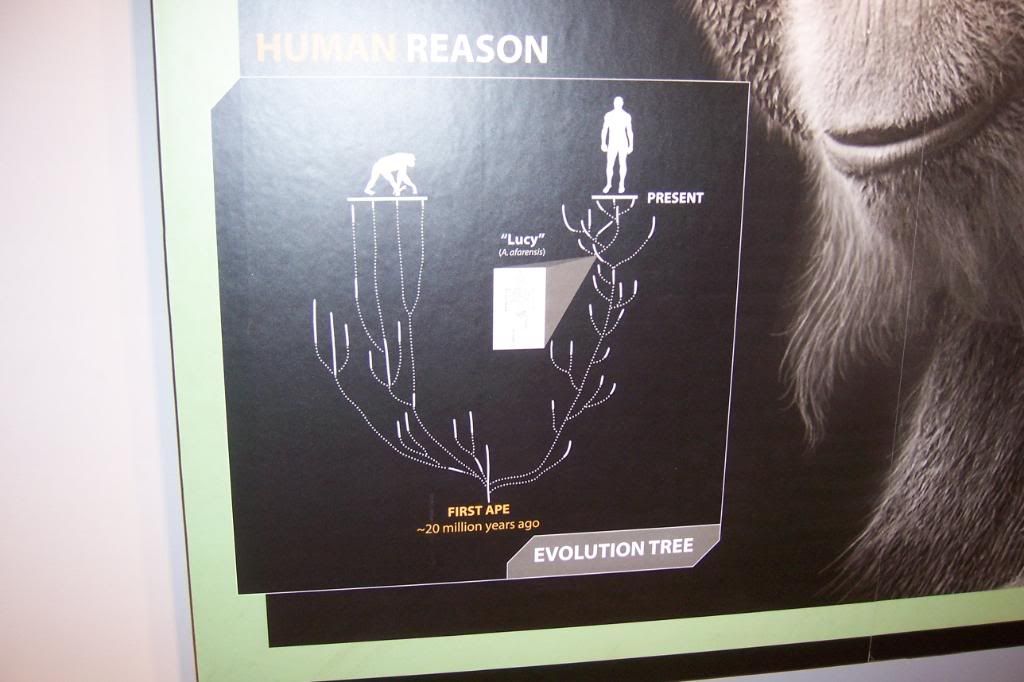
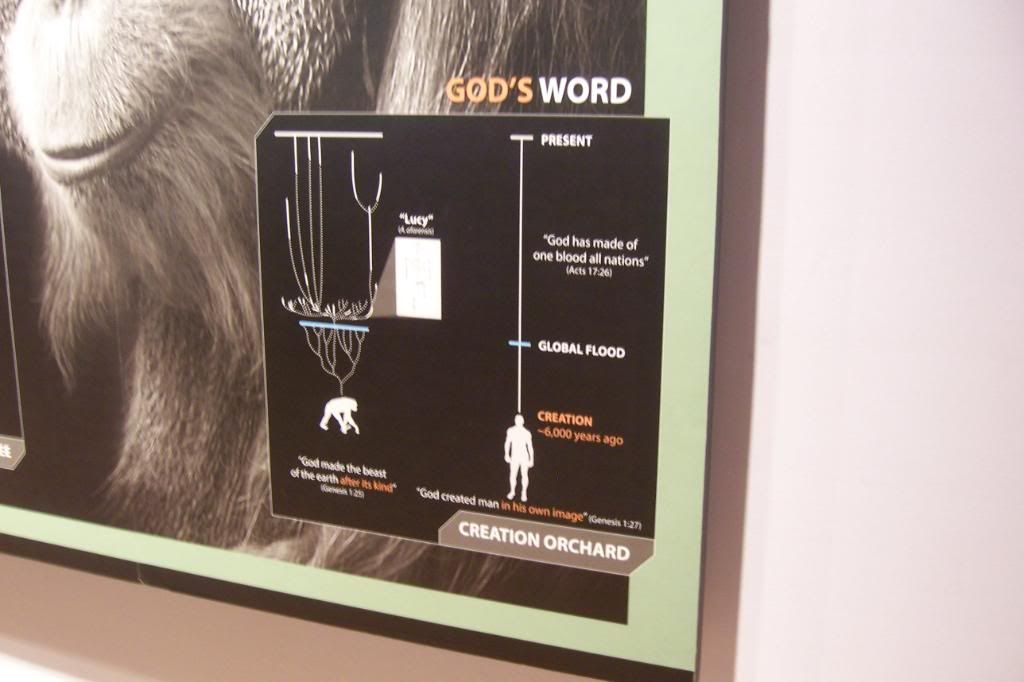
I was impressed in this display on the Human reason side that they put Lucy close to where she would belong in the actually phylogeny. It is true, the evolution of human beings is not the perfect step after step after step that we wish it was. There were many offshoots that we know ended in extinction, and it is hard to determine just which fossils that have been found are our ancestors. However, we do know that there is a relationship between these fossils, us, and the great apes. I was intrigued by the fact that Lucy was placed after the flood, and not before. I am curious to how Lucy could have become buried in just 4,000 years if there had not been a flood to bury her. Most fossils are described in Flood burials, and that is how they all came to be in the ground in different layers. It seems that this is not the case for Lucy, though no explanation is given as to why she is different. It was also amusing to see that Man has not changed one bit in the last 6,000 years. It is good to know that no matter how we try, evolution will never get the better of us!
Same Rocks……Same Fossils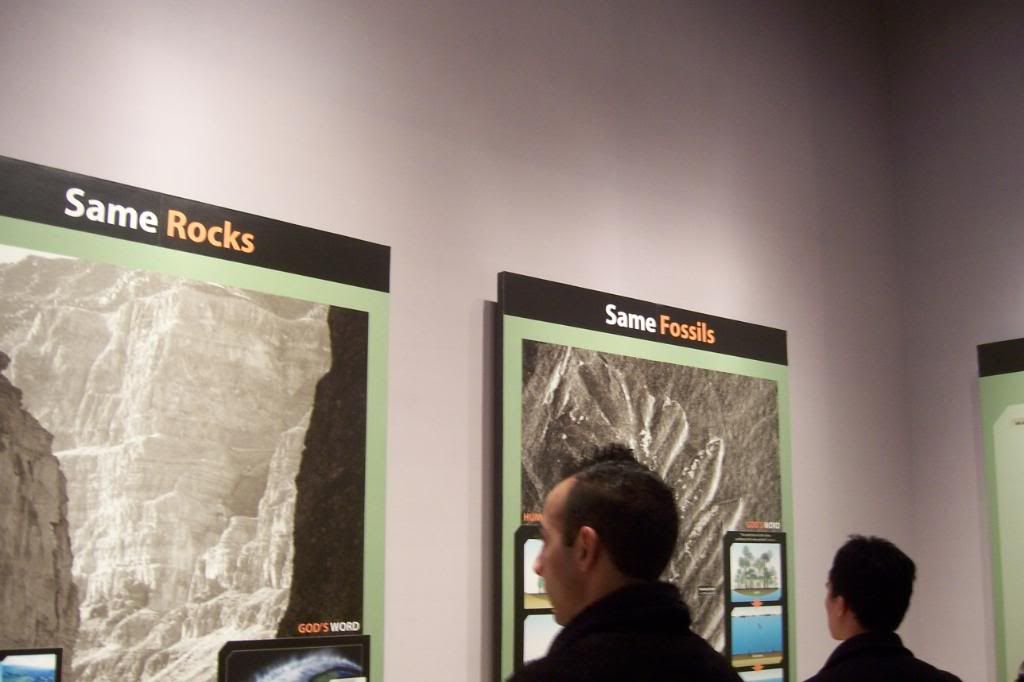
The same rocks and the same fossils can lead scientists to believe that the world is 4.6 billion years old and that strata were laid down over long periods of time and that the fossils within them represent different periods of time in Earth’s grand history and can lead creationists to believe that God’s global flood put down all the layers of sediment simultaneously and the fossils are simply the animals left off the ark. It seems to me that they are not actually looking at the rocks or fossils, or they would have a different view. There is an entire room devoted to these ideas, so I will get into this in more detail later.
Different Views of Time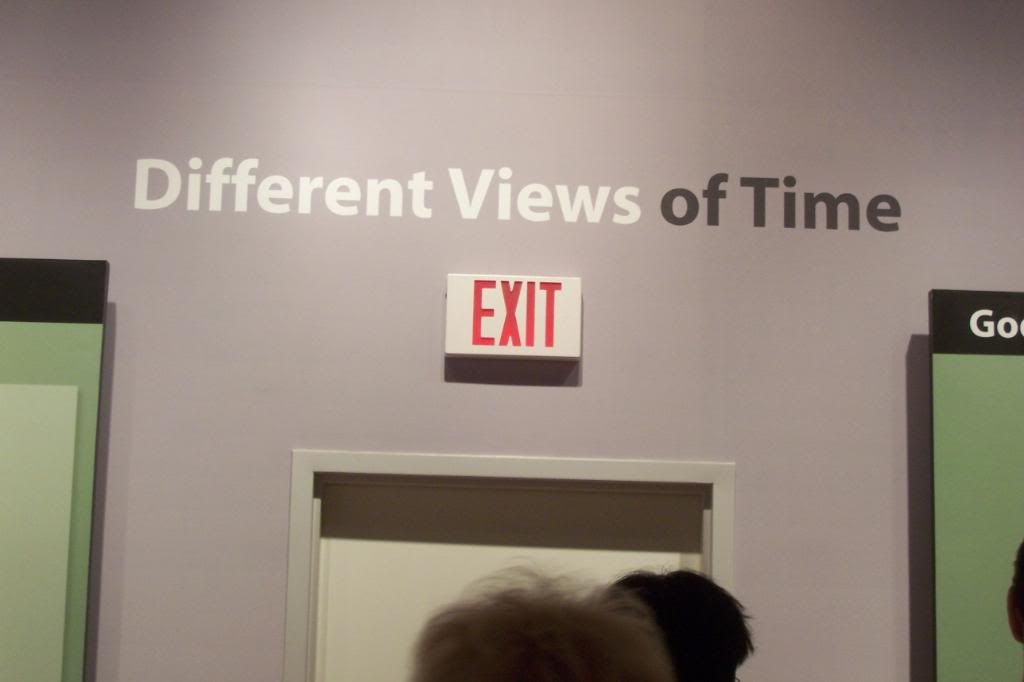
The present is the key to the past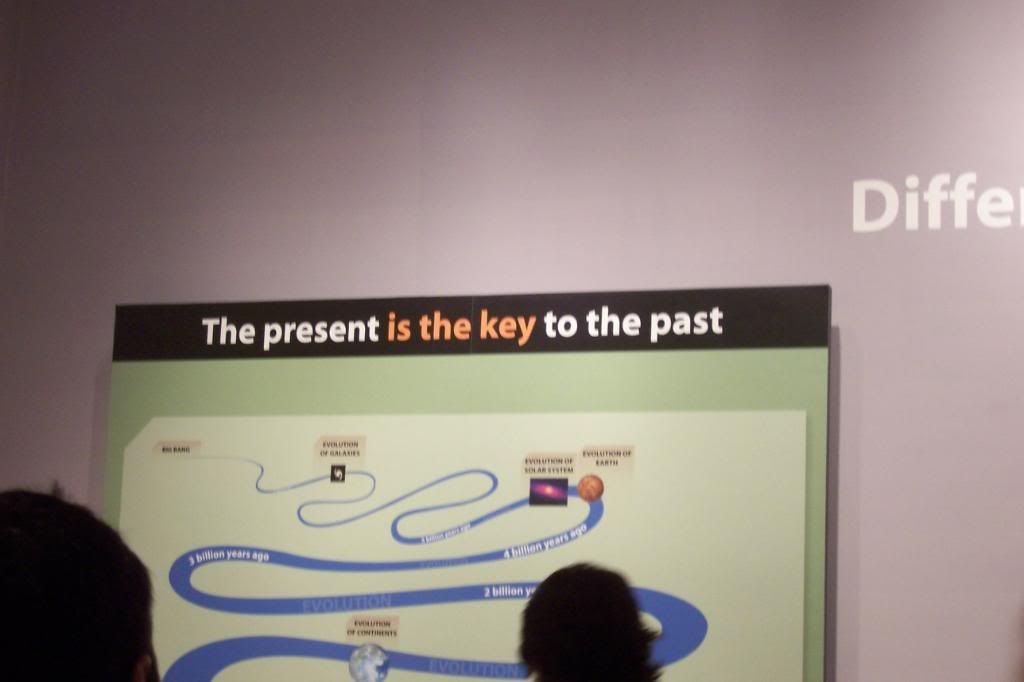
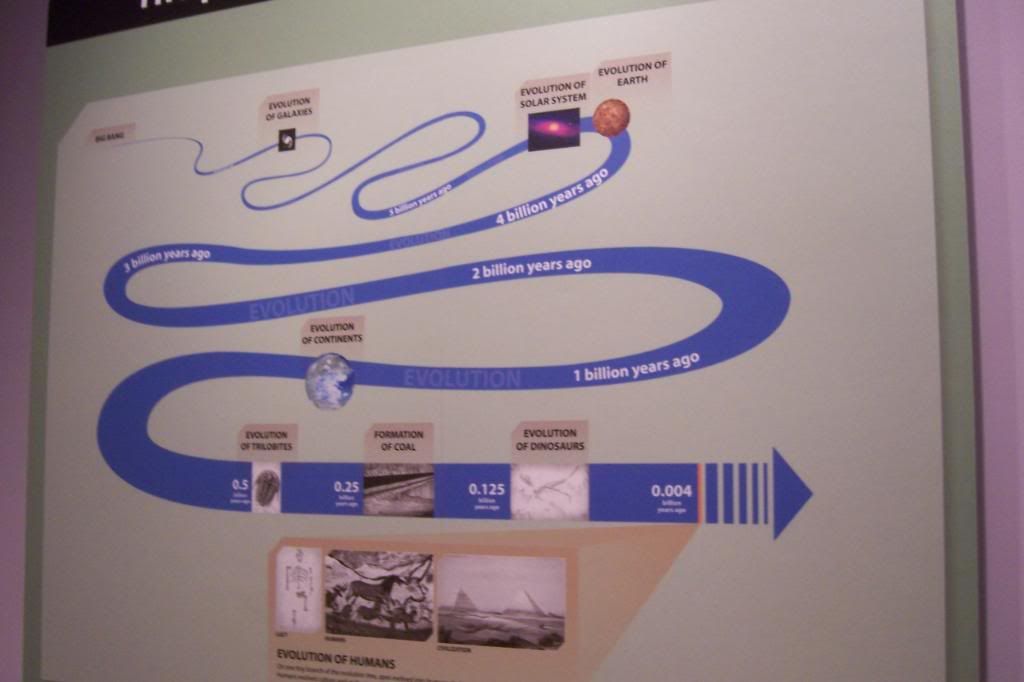
This picture of the evolution of life is close, but not what we teach in evolution or geology classes. First of all, trilobites may have come onto the scene there, but they evolved for much longer after that. Until their demise they were always evolving. This is a misconception of what evolution is, I think. There seems to be this split between something evolving into a “kind” and then variety within a “kind” whereas scientists explain both of these processes in one fell swoop. Formation of coal? WHAT? Coal forms in many different layers from many different times. They are going for the coal deposits of the Carboniferous (which helped to give this time its name), but that is not the only time that coal has been formed.
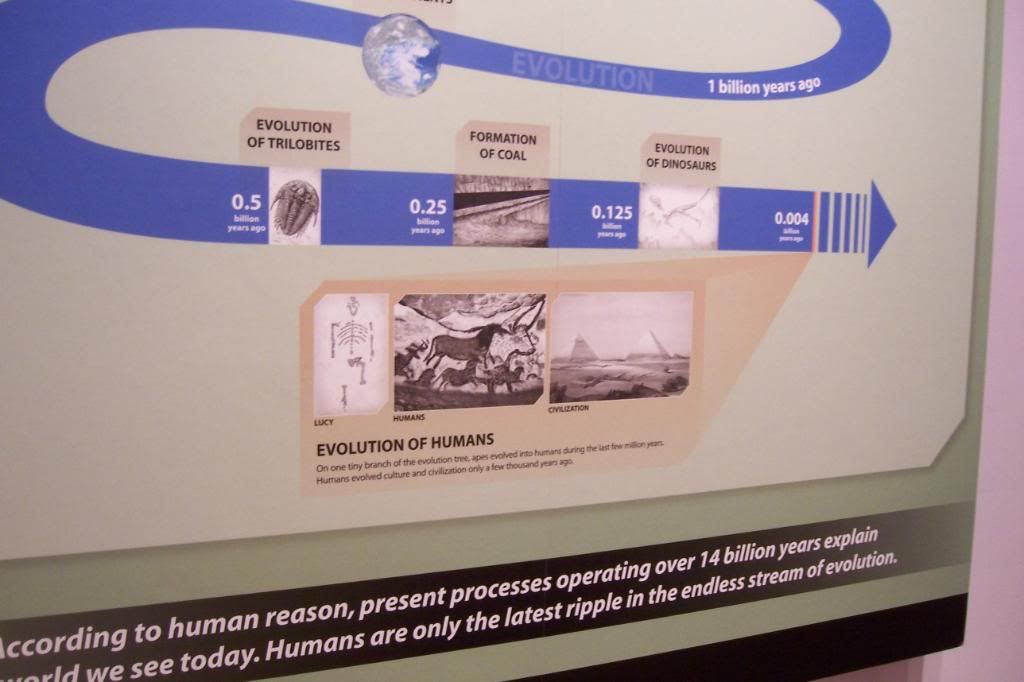
We are not special. This is one of the main problems creationists have with evolution. If we were simply “the latest ripple” then what is the point? There is no love from God for us if we are not made in his image. It would stand to reason then, of course, that God does not love the rest of his creations as much as he loves us. Though this may be incredibly anthropocentric, it is one of the ideas that drives the creationist movement forward. We have to be special, we’re human! We do not belong on a “tiny branch”!
God’s Word is the key to the past, present, and future
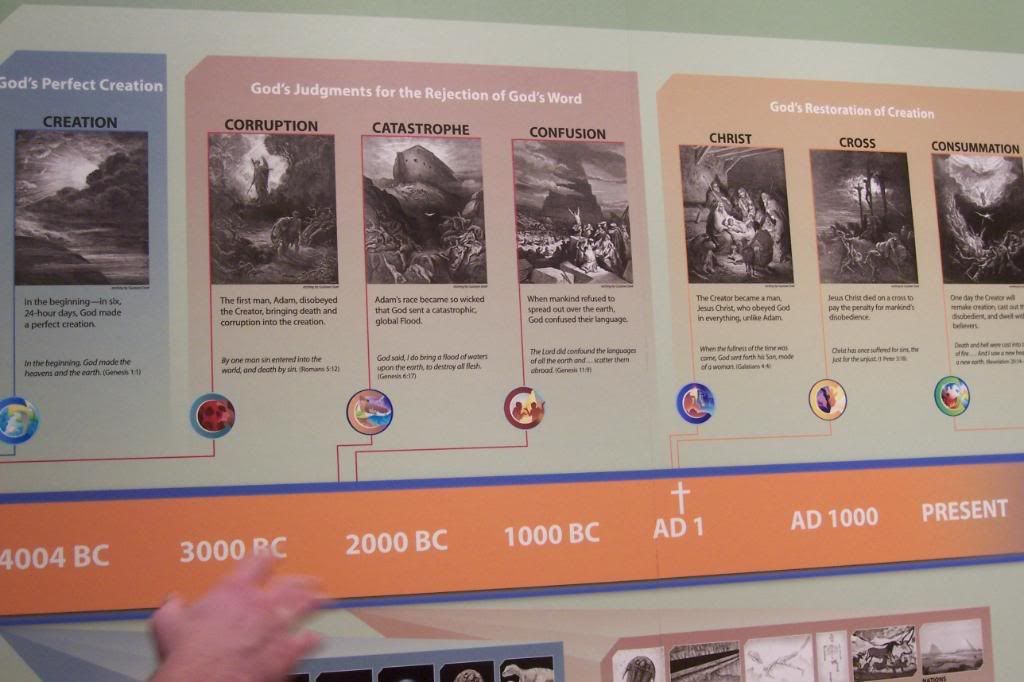
This is a good quick recap of those seven C’s that had been introduced at the beginning of the museum. Each of the parts of this will again be displayed in the museum, and I will go into depth with each in turn, but this is a good basic overview.
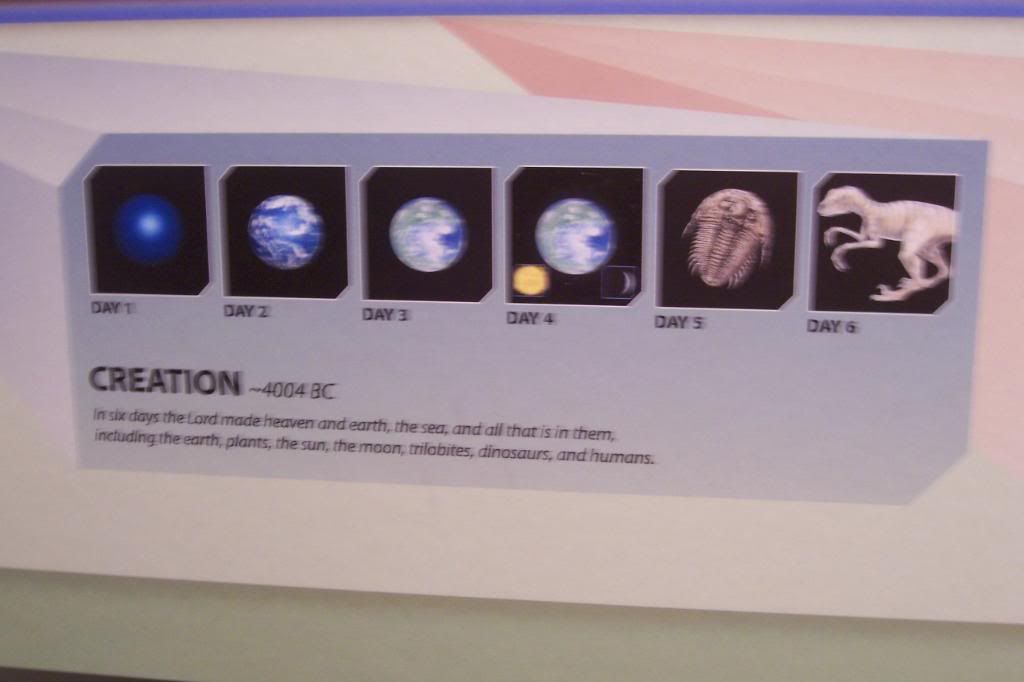
God created everything in six days, according to a literal reading of one of the chapters of Genesis (the other is usually played off as a mistranslation of the original language). We will get a full interpretation of creation later, but with the trilobites and dinosaurs placed thusly on this diagram, it gives you a very good idea of how the creationists try to reconcile direct biblical verse with the evidence that screams “evolution.”
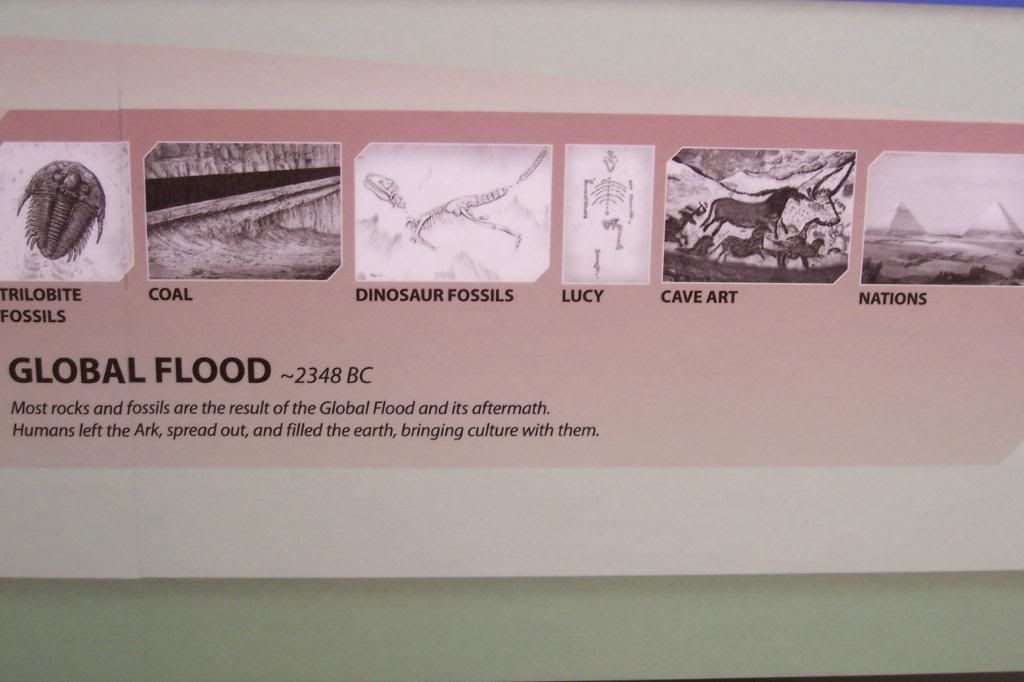
Now this is very interesting. Just a half a room away there is a poster that tells me Lucy lived after the flood. I wonder what could account for this disparity. I wonder which view is correct in this one case of Lucy’s timing in relation to the Flood.
But There’s More! 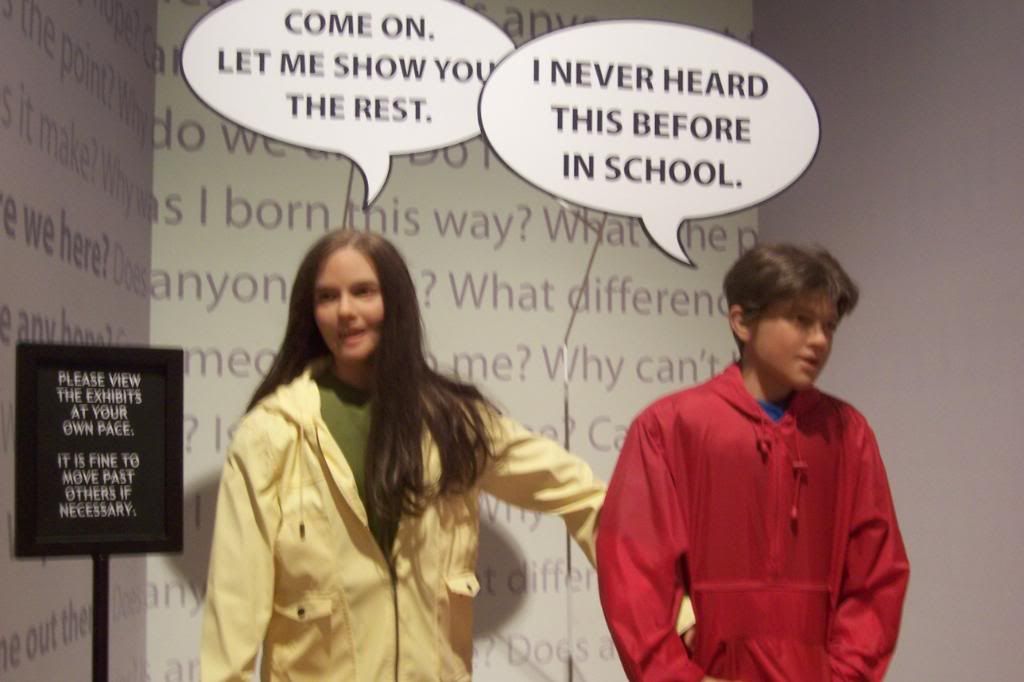
Again the horror of how much this museum is designed for children. Also, the sign basically says “survival of the fastest”.